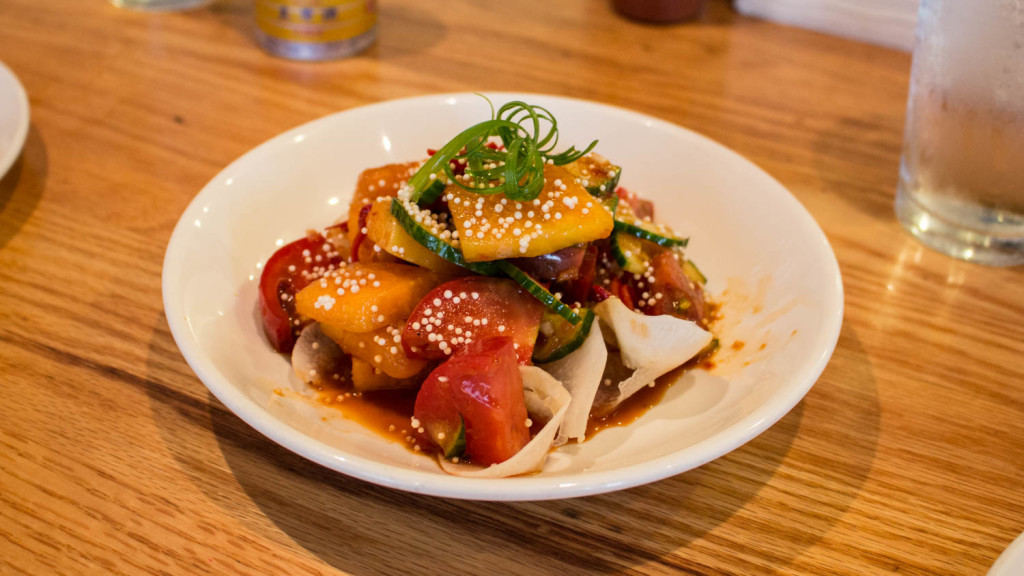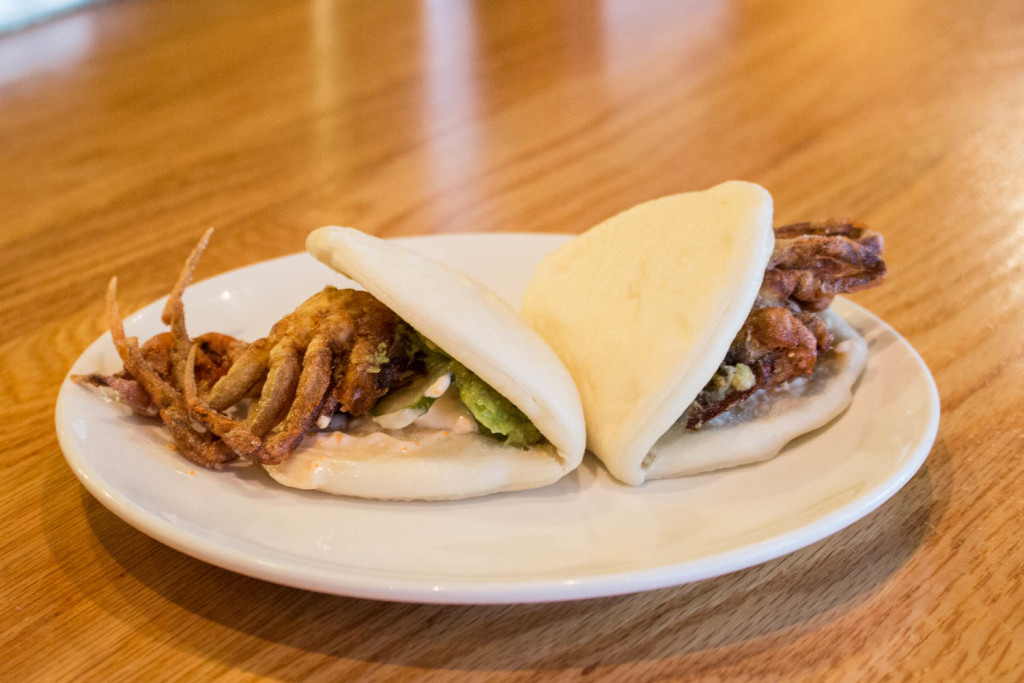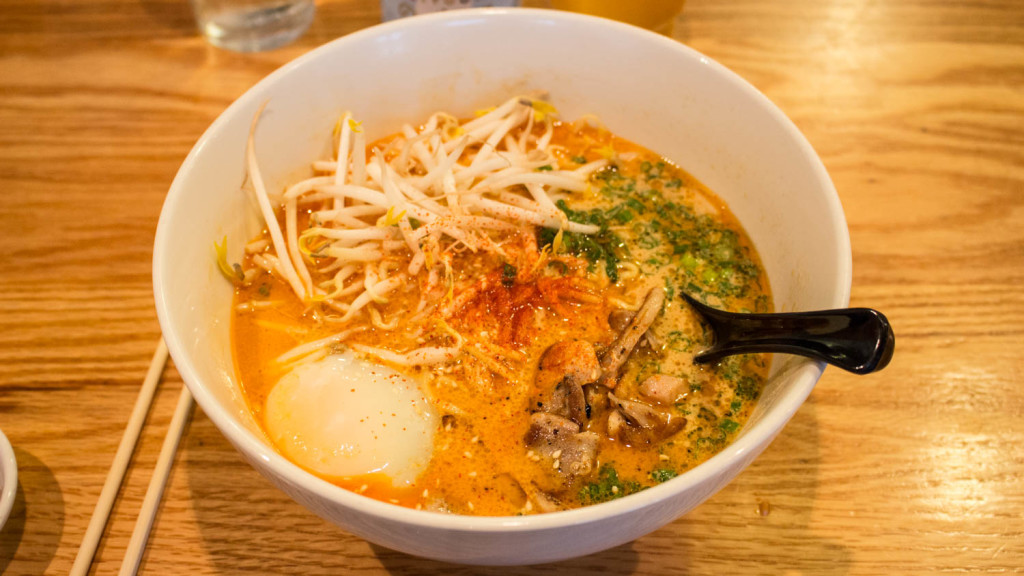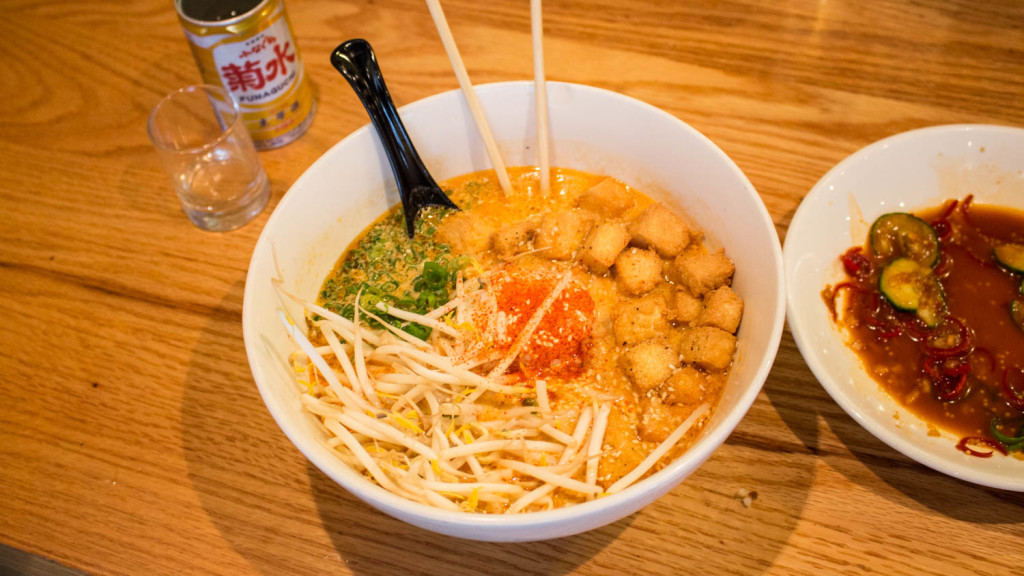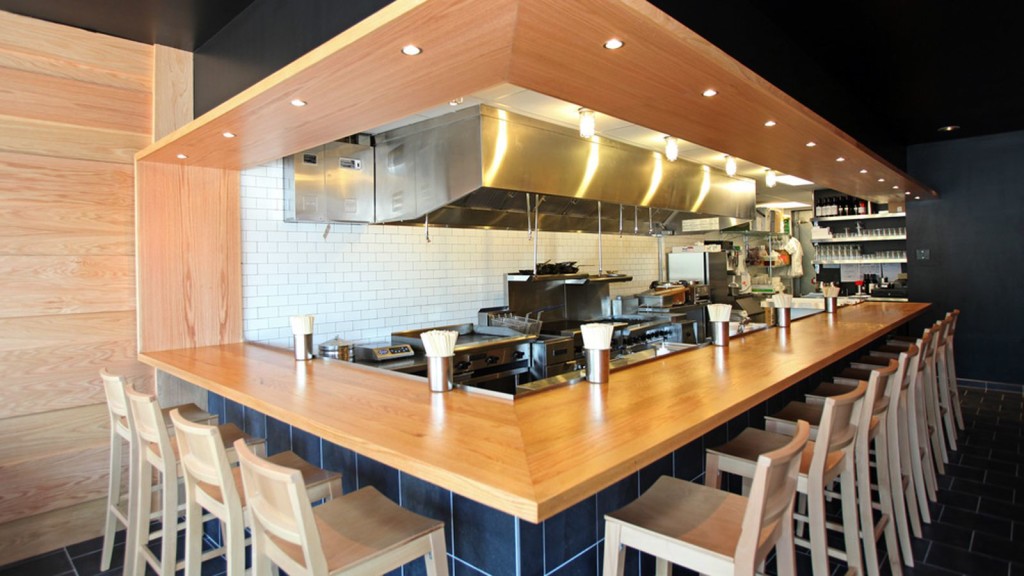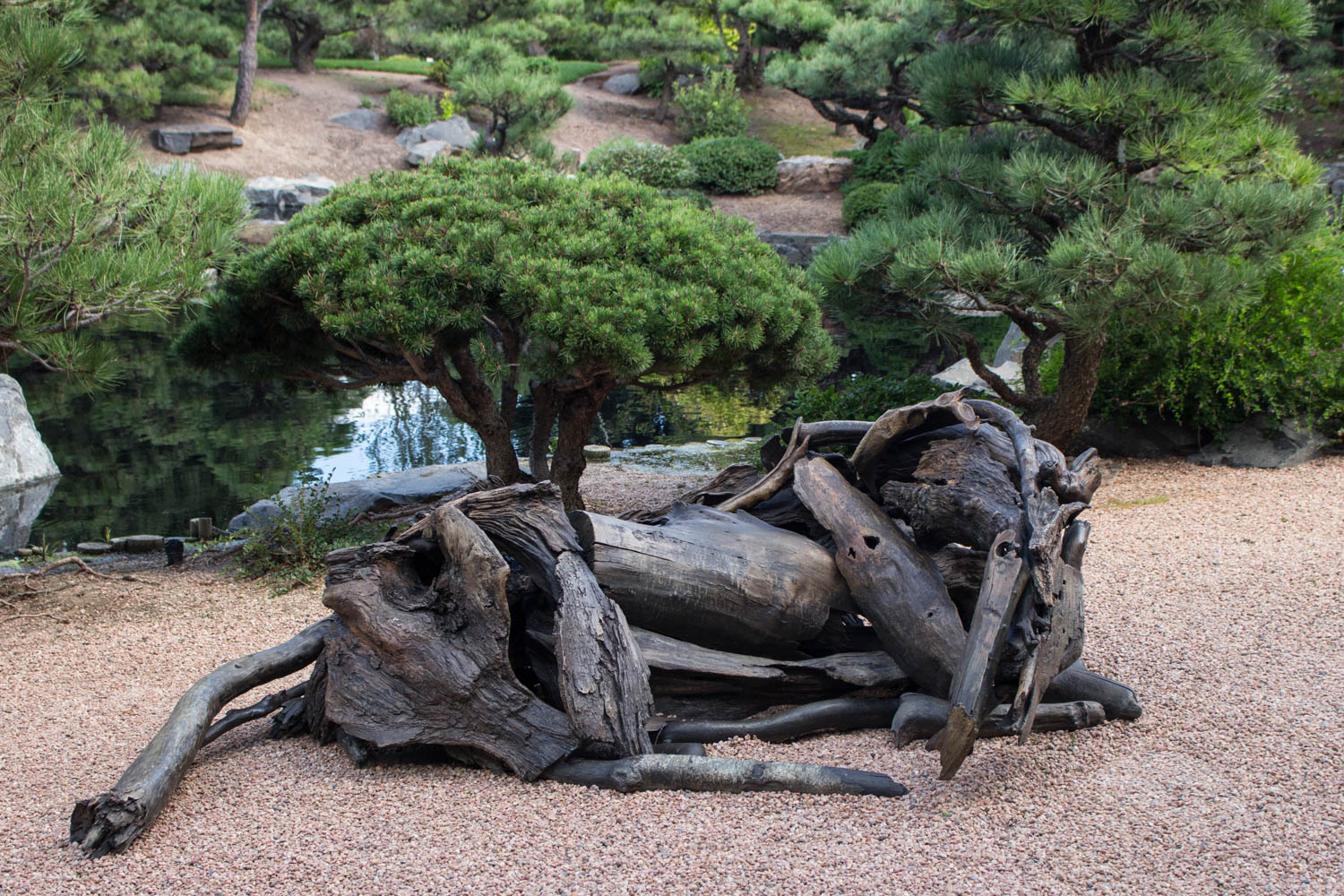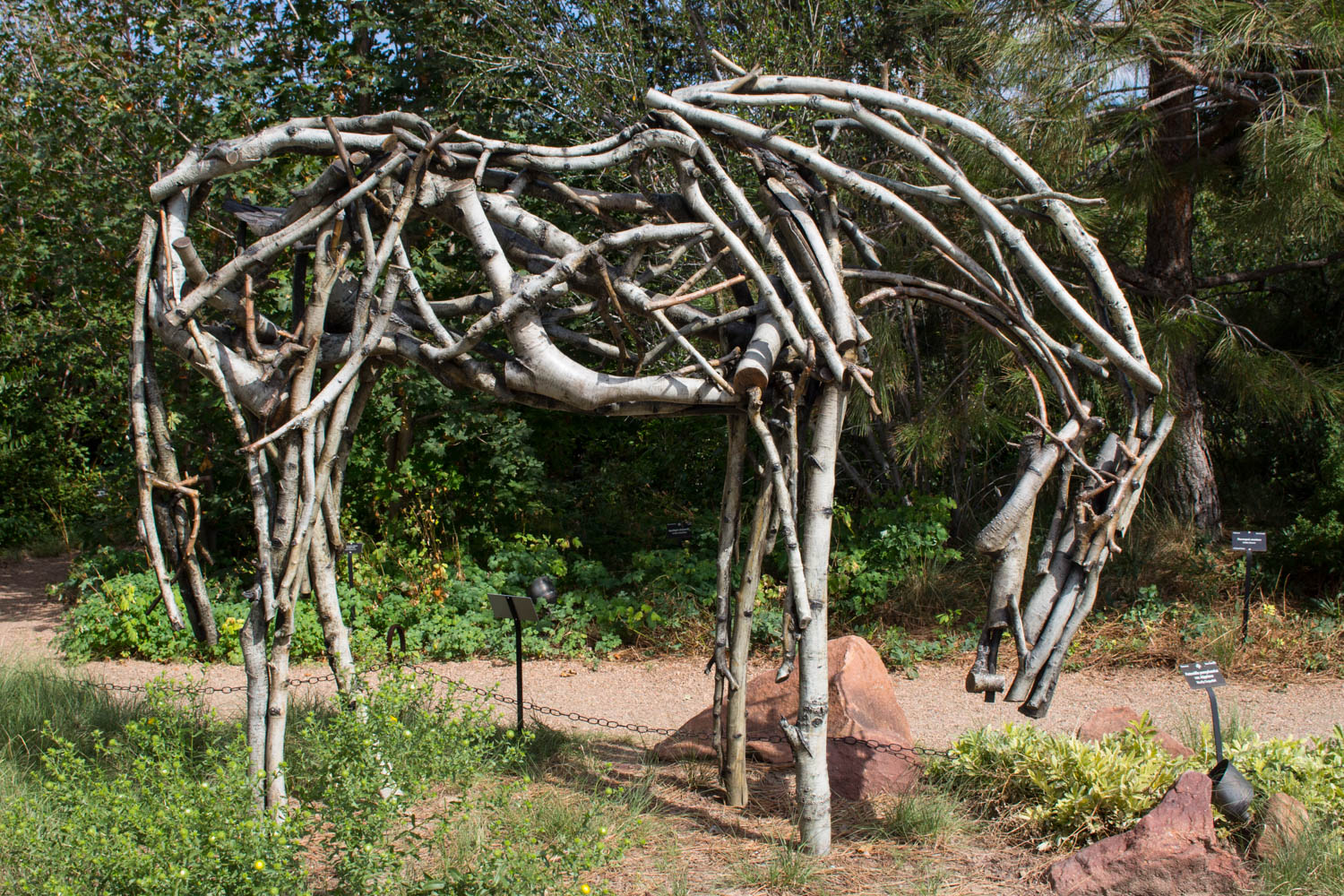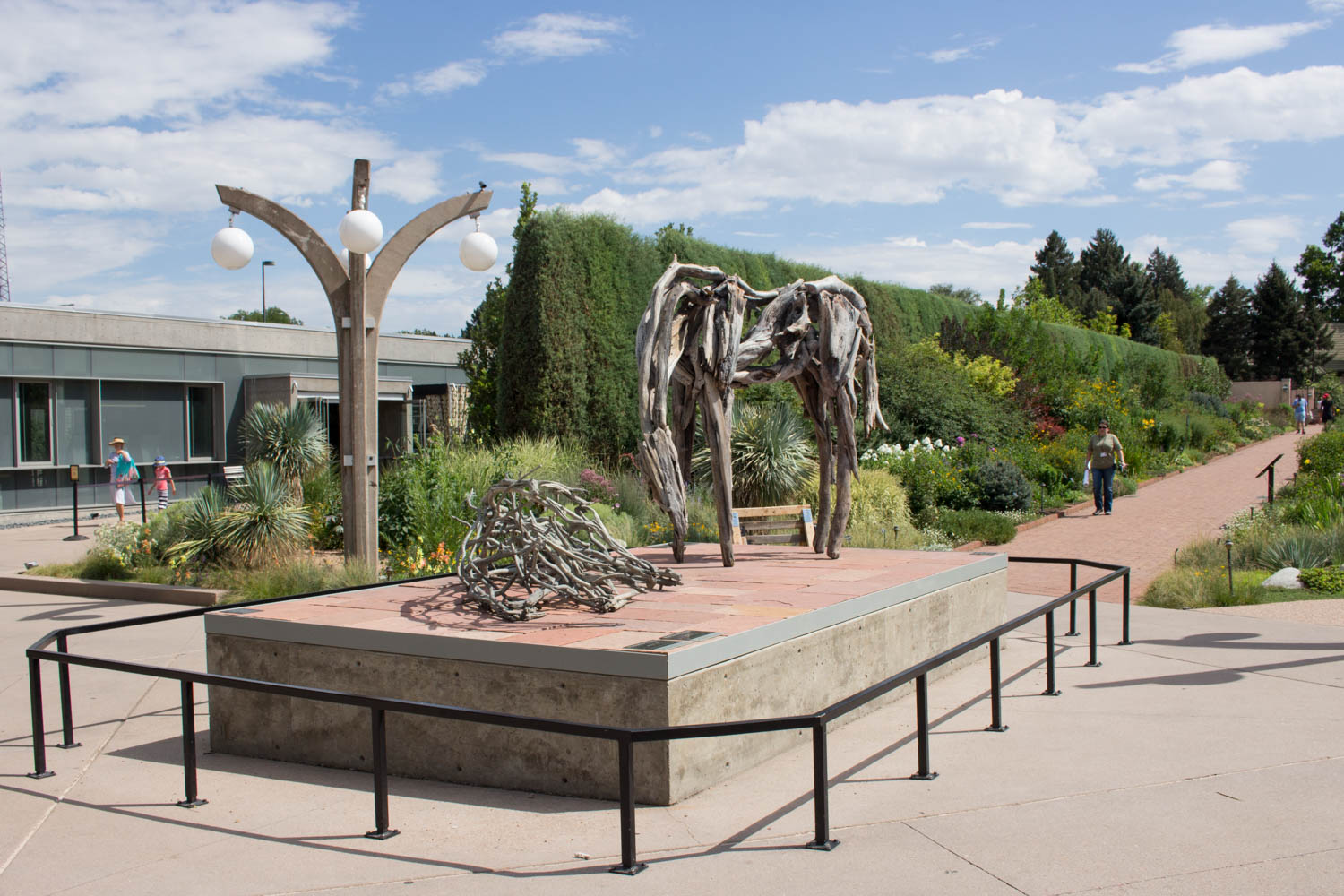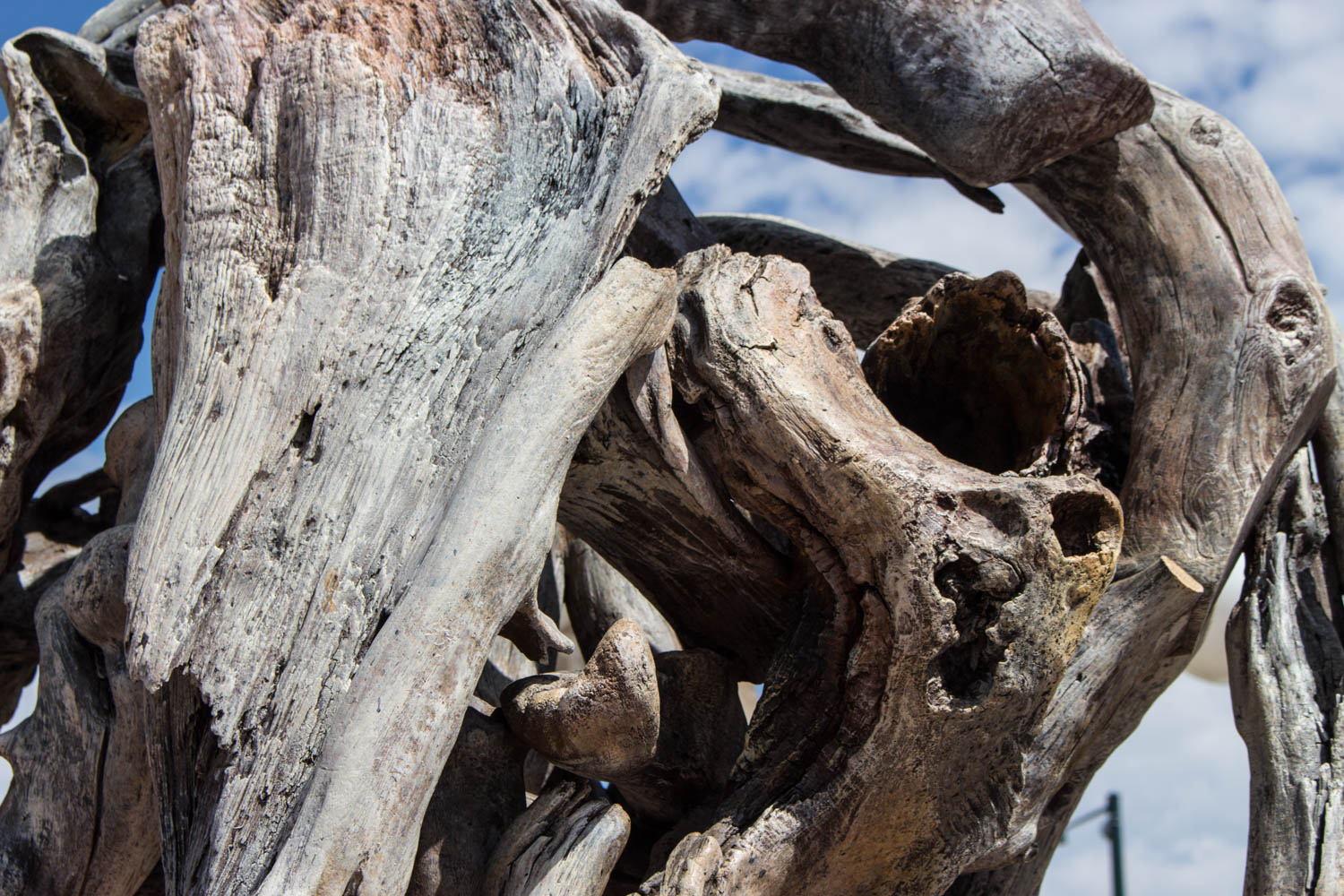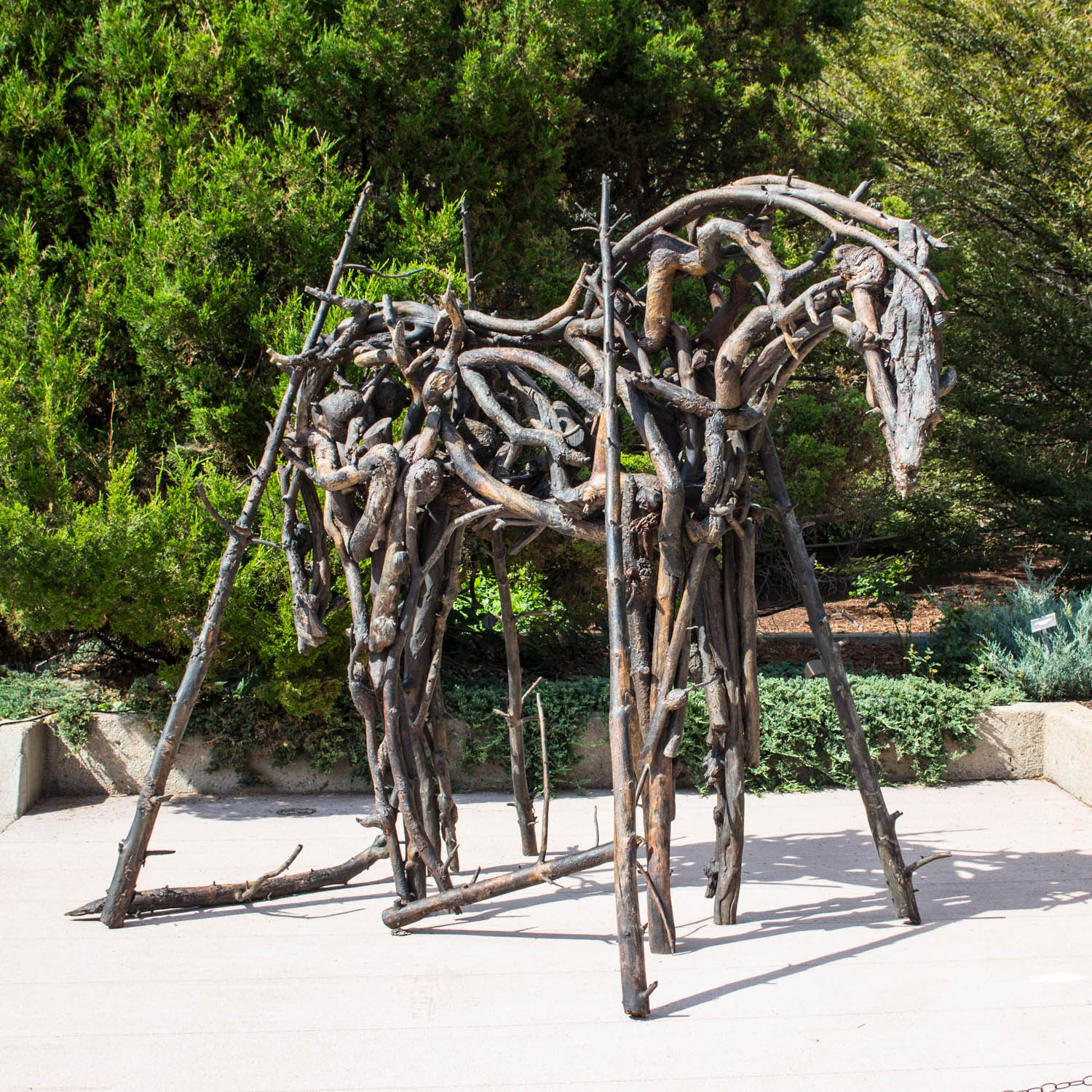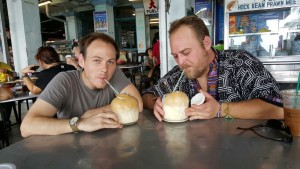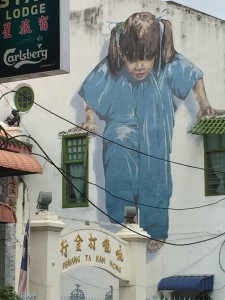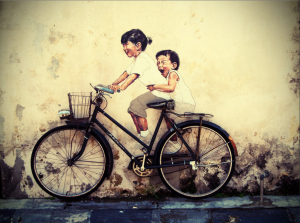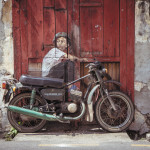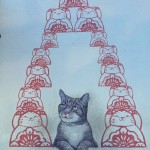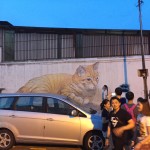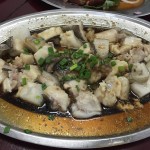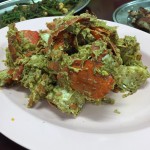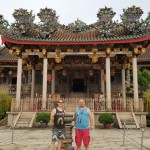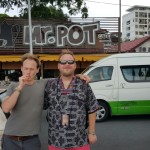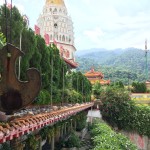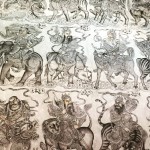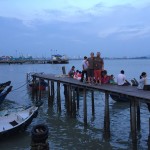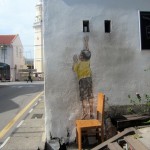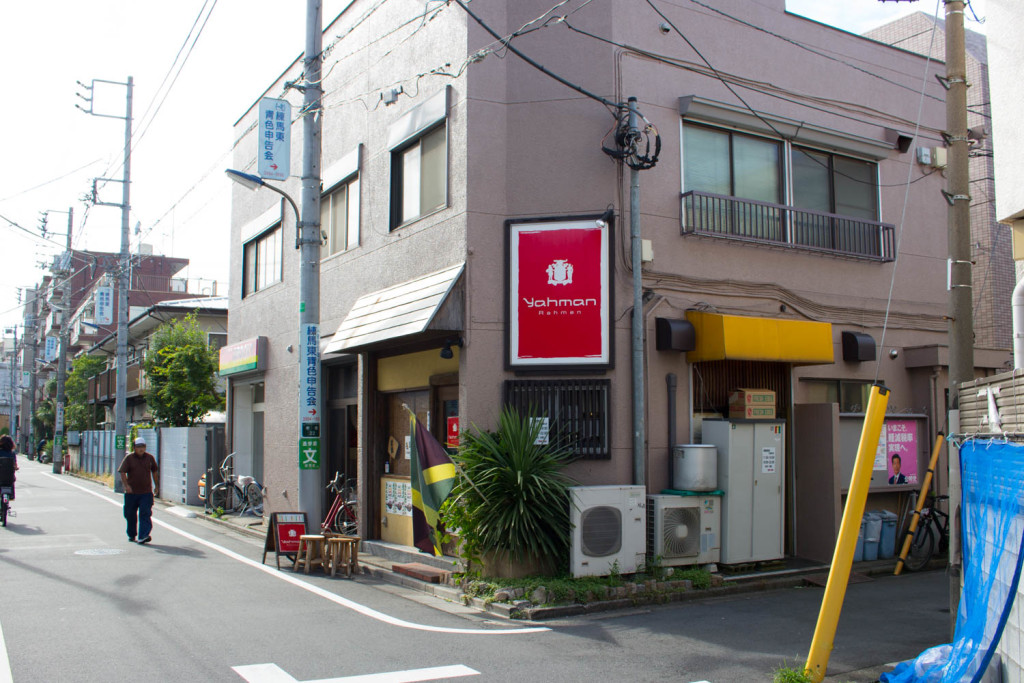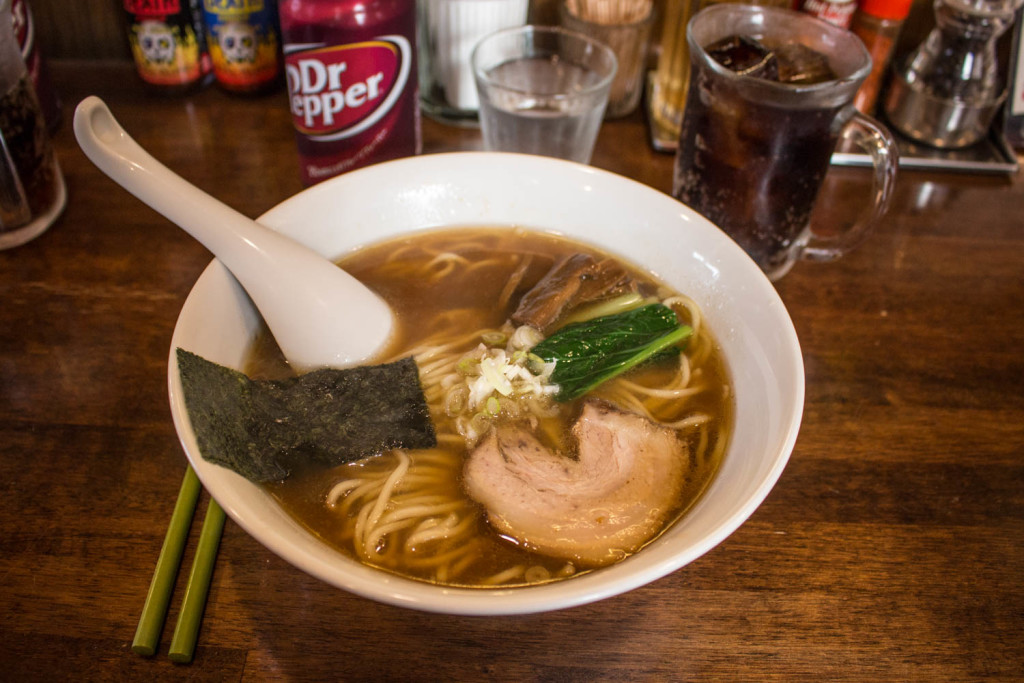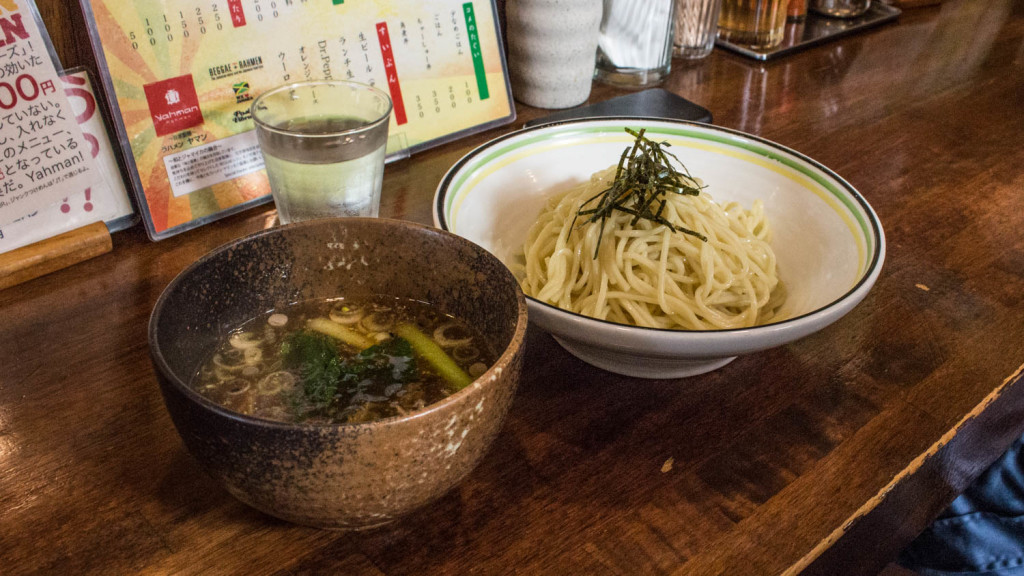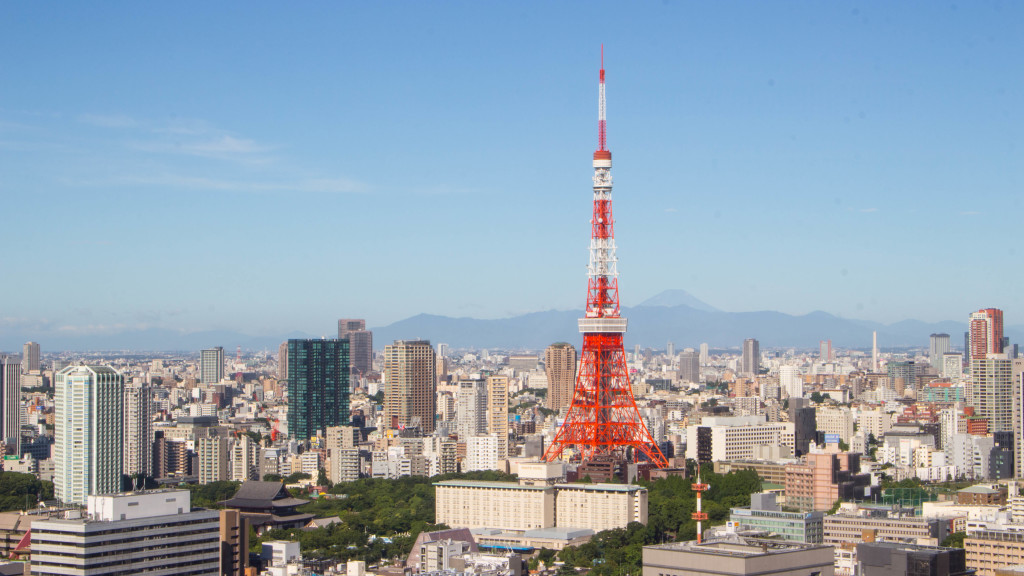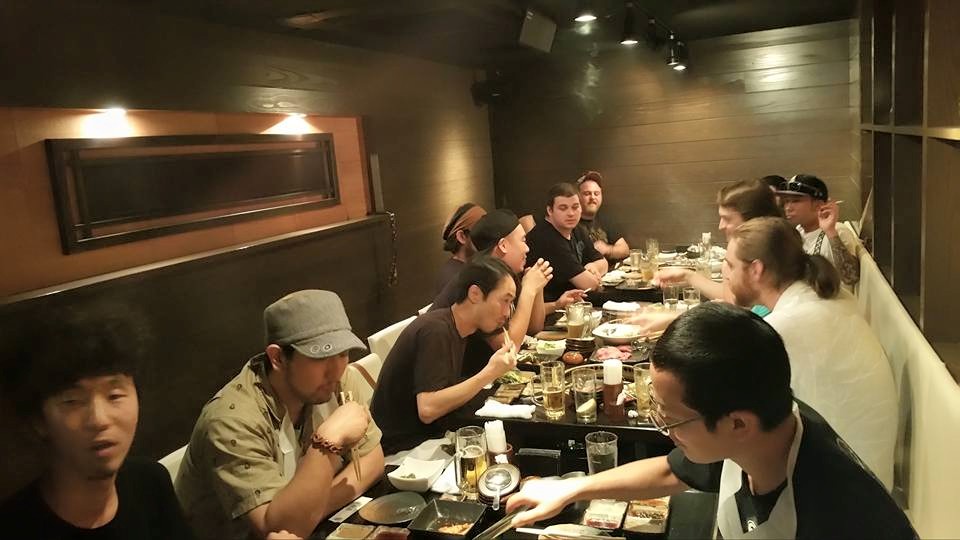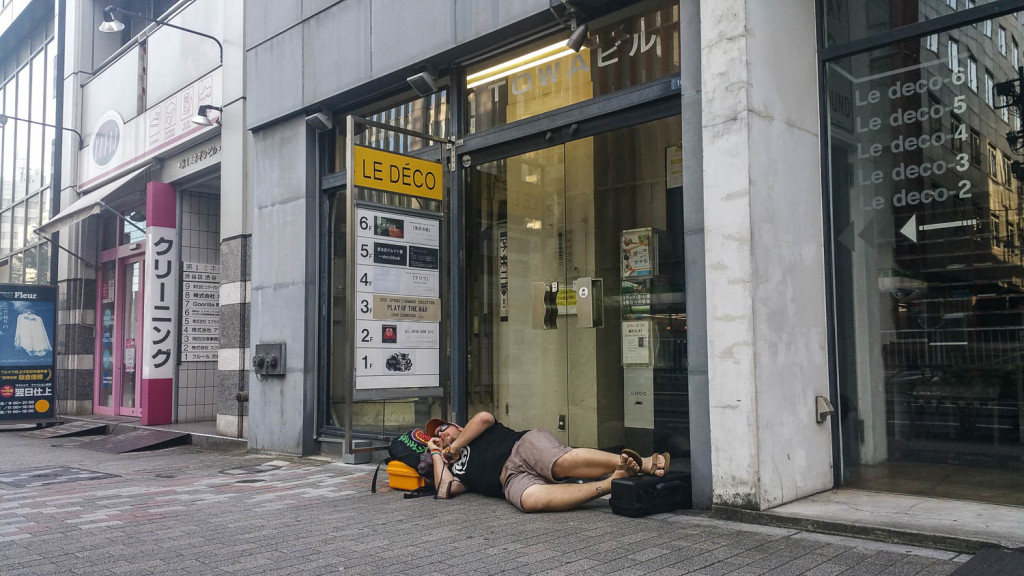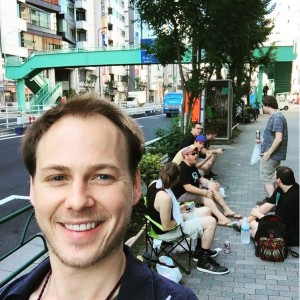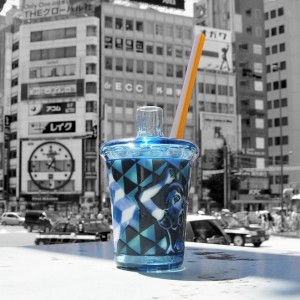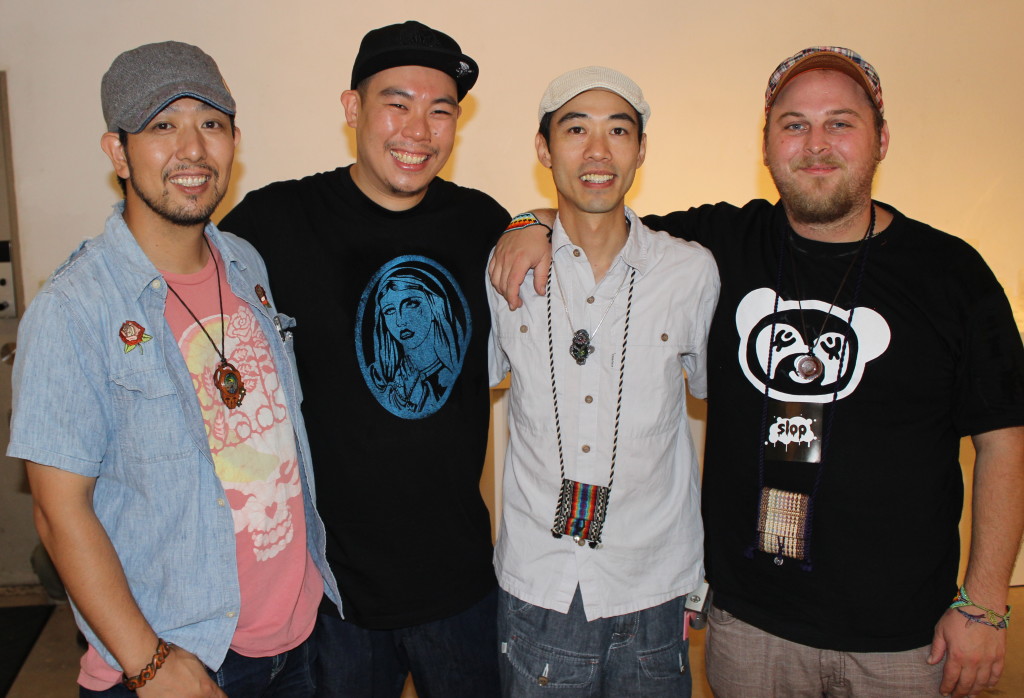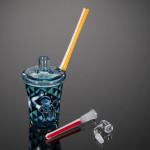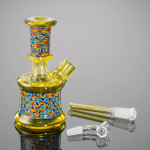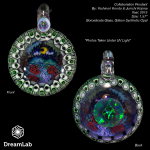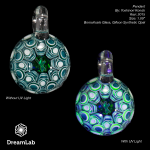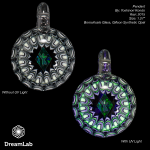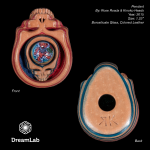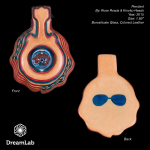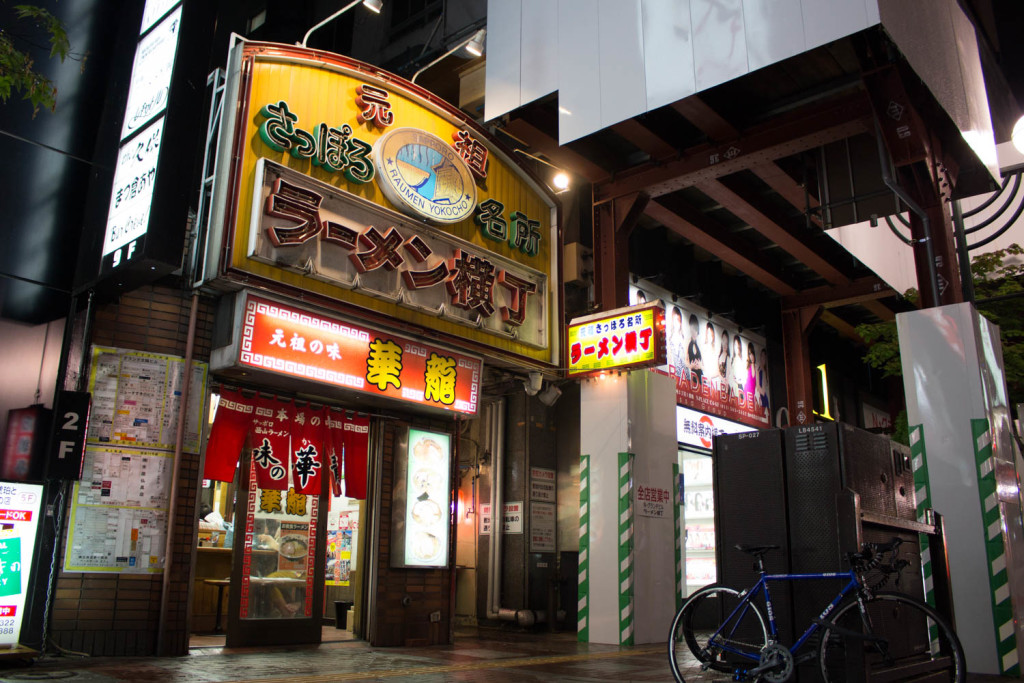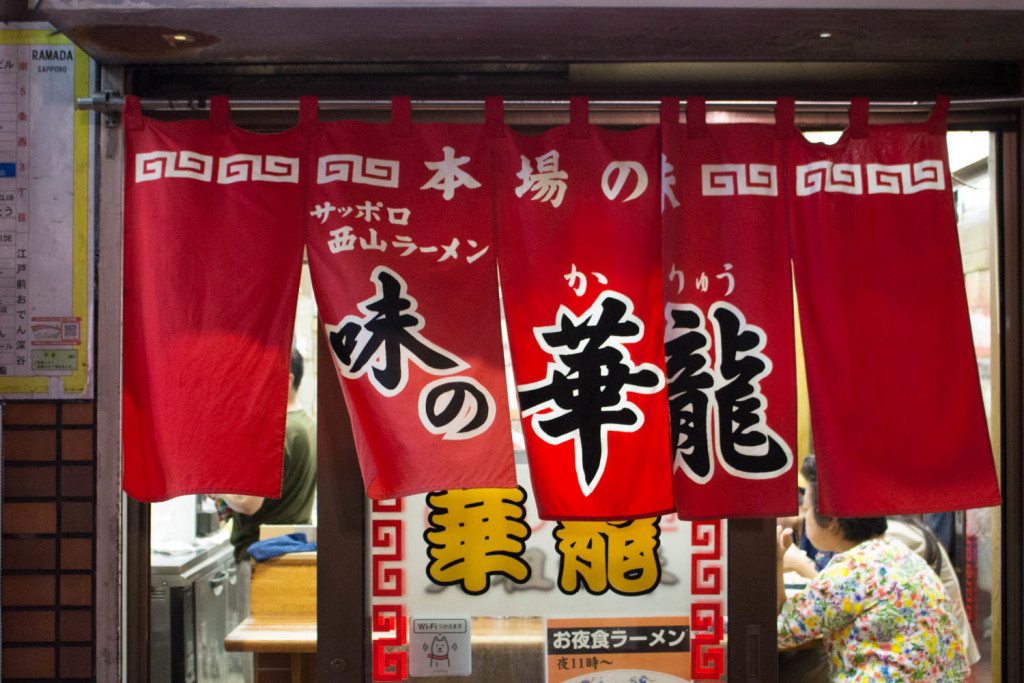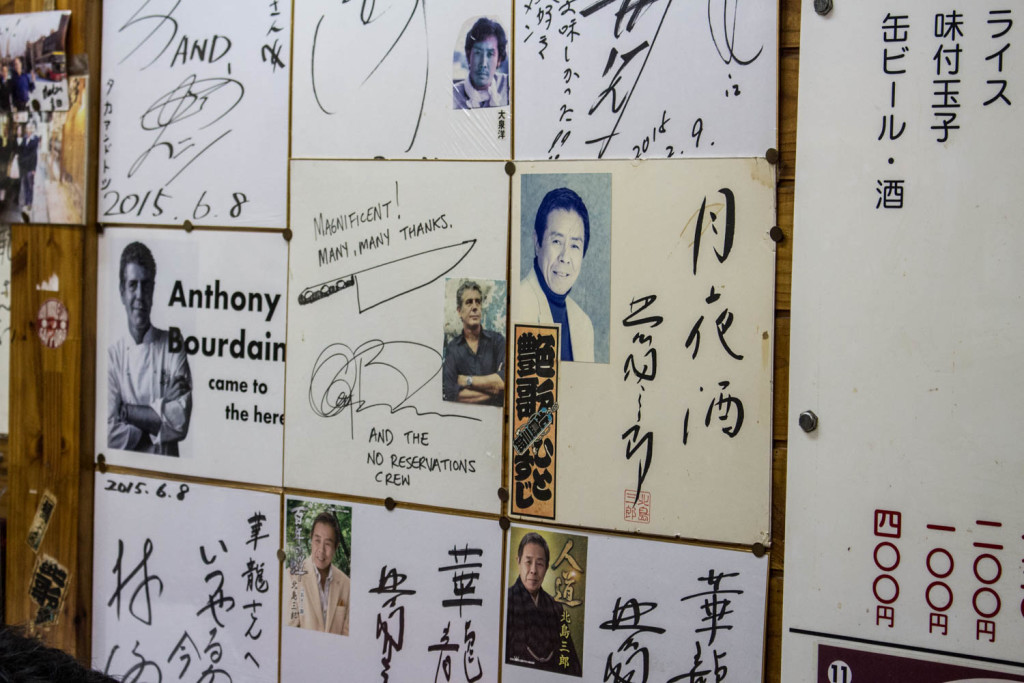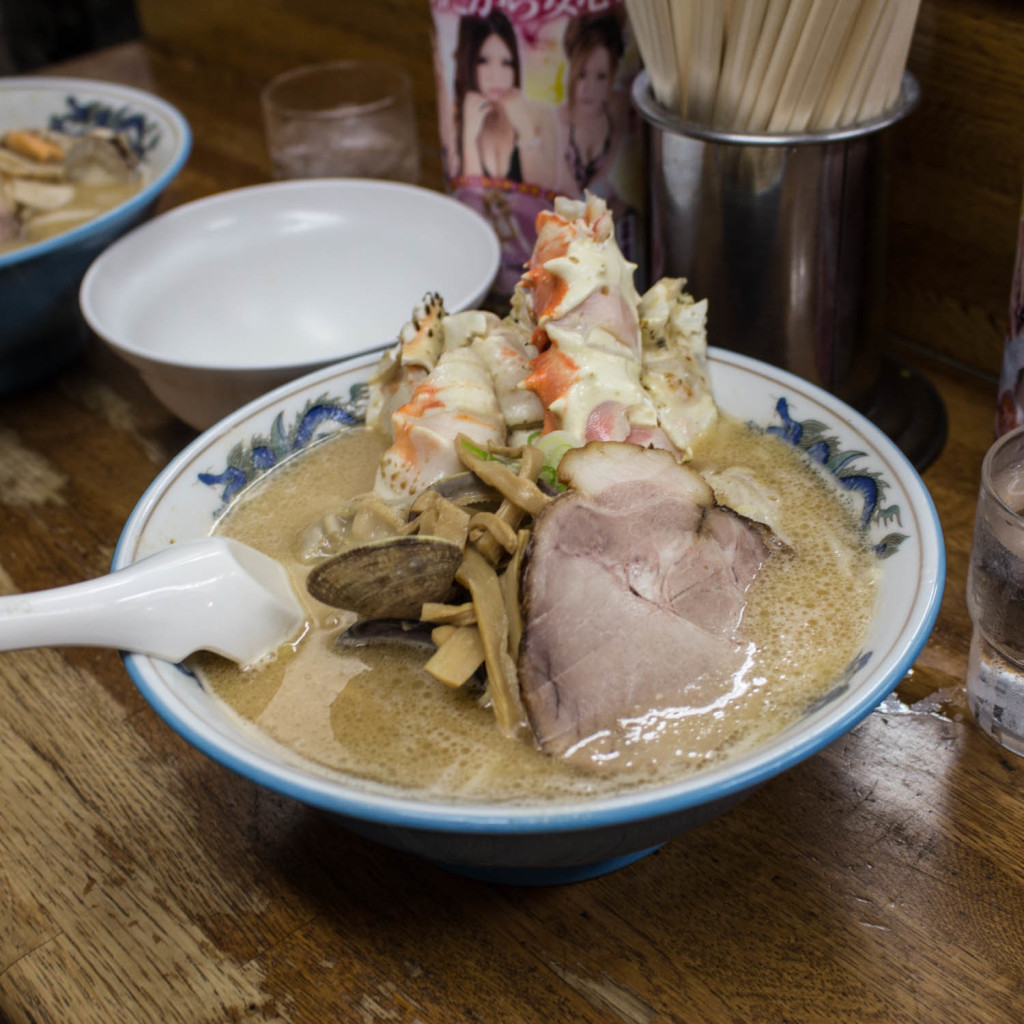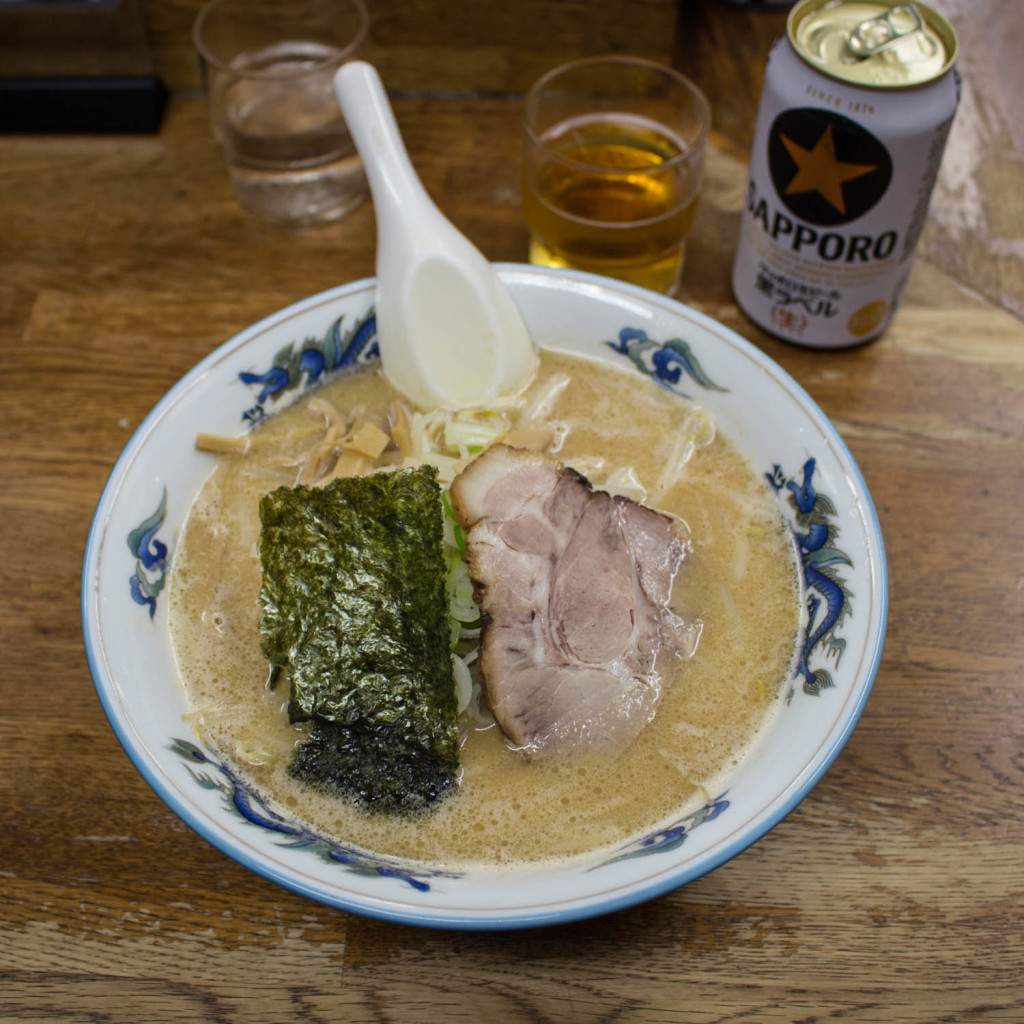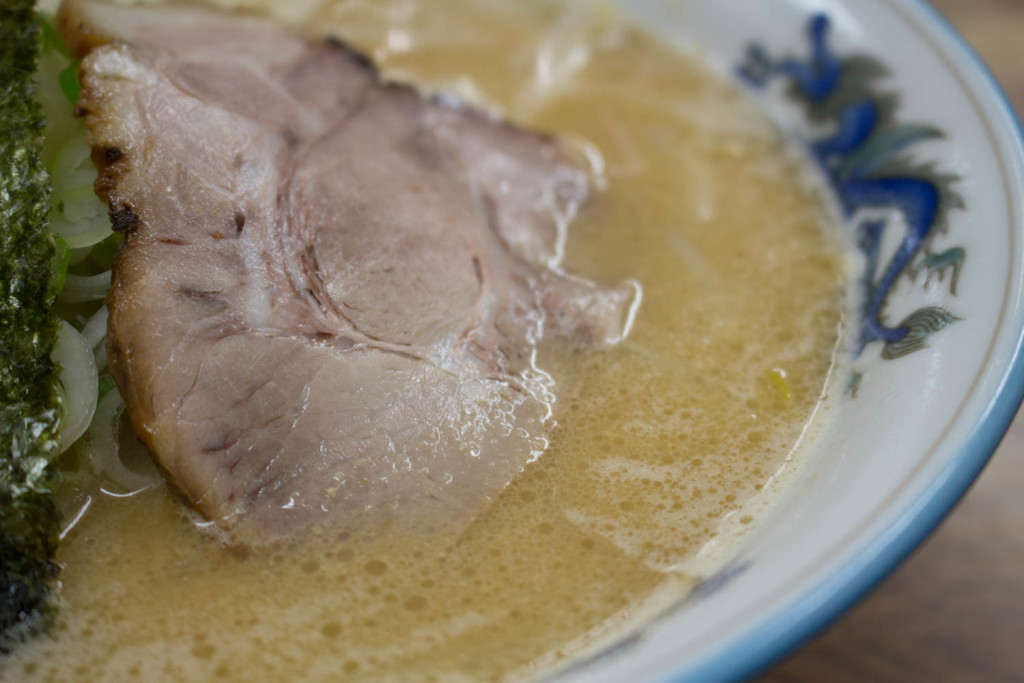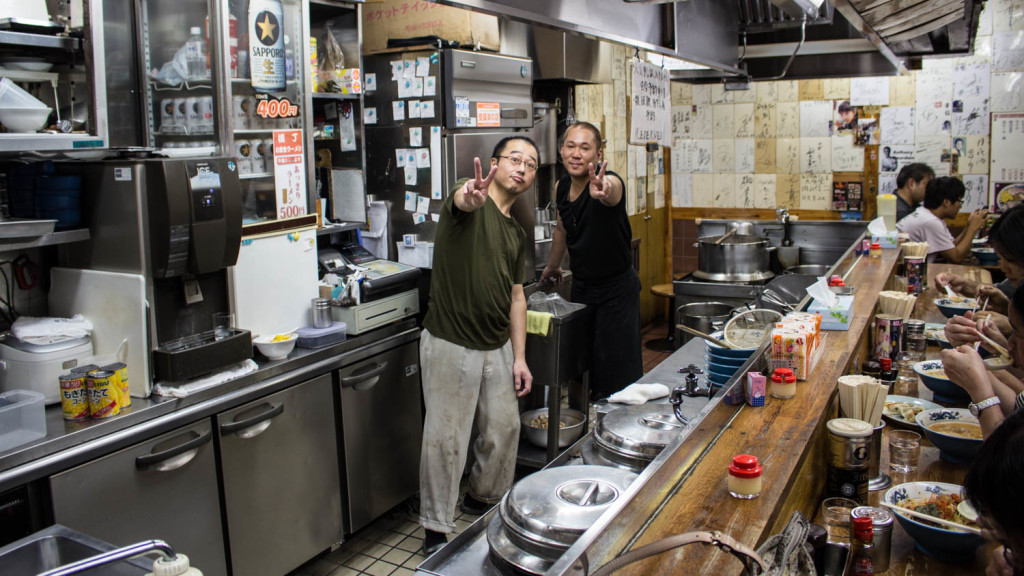Welcome to the DreamLab Blog.
Highlighting the best of the glass world, fine art, culture, and lifestyle as they relate to contemporary cannabis culture.Jerry Kelly: Live in Salem – Recap
Last Saturday, DreamLab teamed up with legendary glass artist and murrine-maker Jerry Kelly on a series of limited edition pieces featuring our 2017 lineup for his first solo show Jerry Kelly: Live in Salem at Witch Dr. glass gallery in Salem, MA.
Photographer Nick Cosentino was at the event and managed to capture some amazing photos featuring DreamLab pieces.
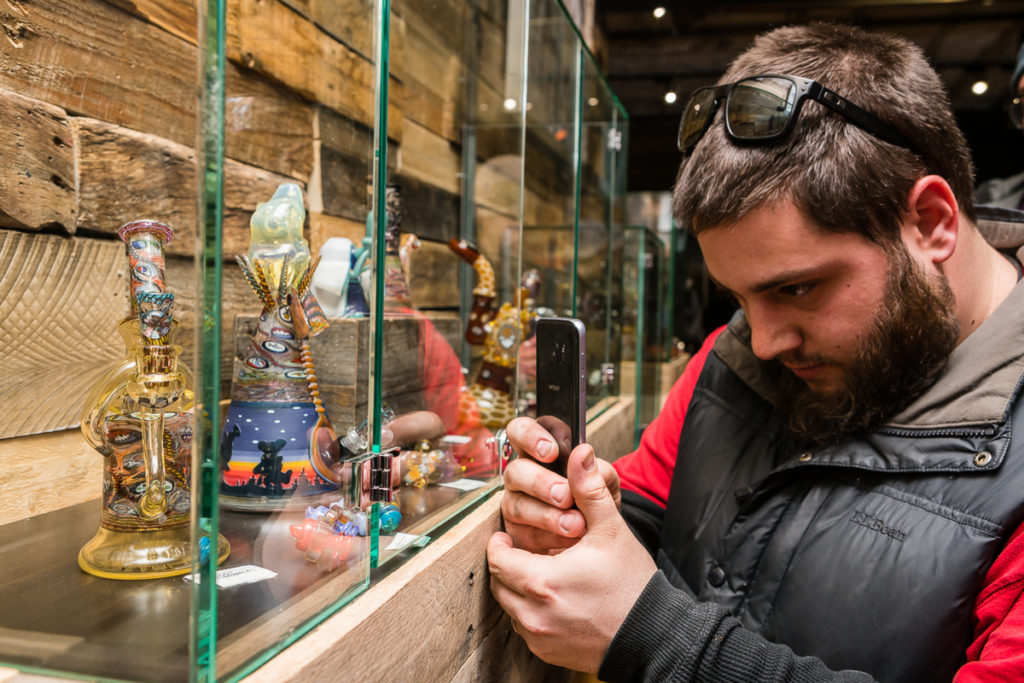
The Jerry Kelly collaboration Hemisphere is always ready for it’s photo-op. – ©Nick Cosentino
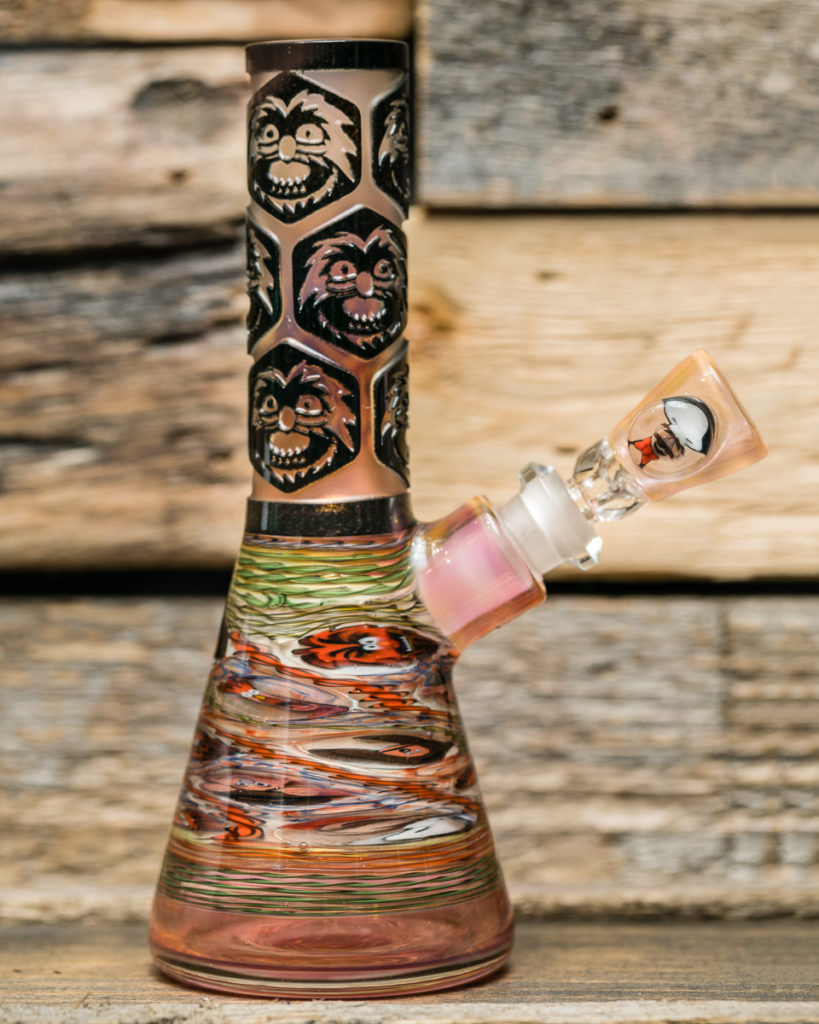
‘Electric Mayhem’ Spartan mini-tube collaboration with Jerry Kelly. – ©Nick Cosentino
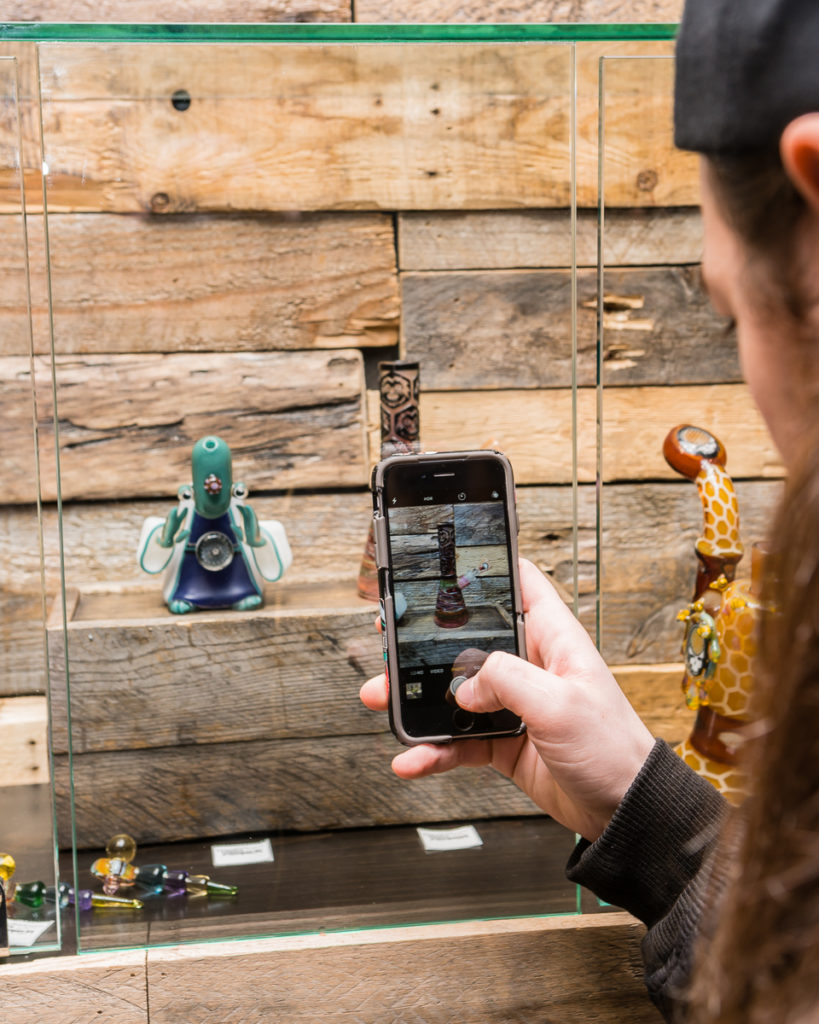
The DreamLab x Jerry Kelly collection was displayed alongside collaborations with DreamLab team members as well as our founder Joe P. – ©Nick Cosentino

‘Quasi’ by DreamLab team-member Mongrel & Jerry Kelly – ©Nick Cosentino
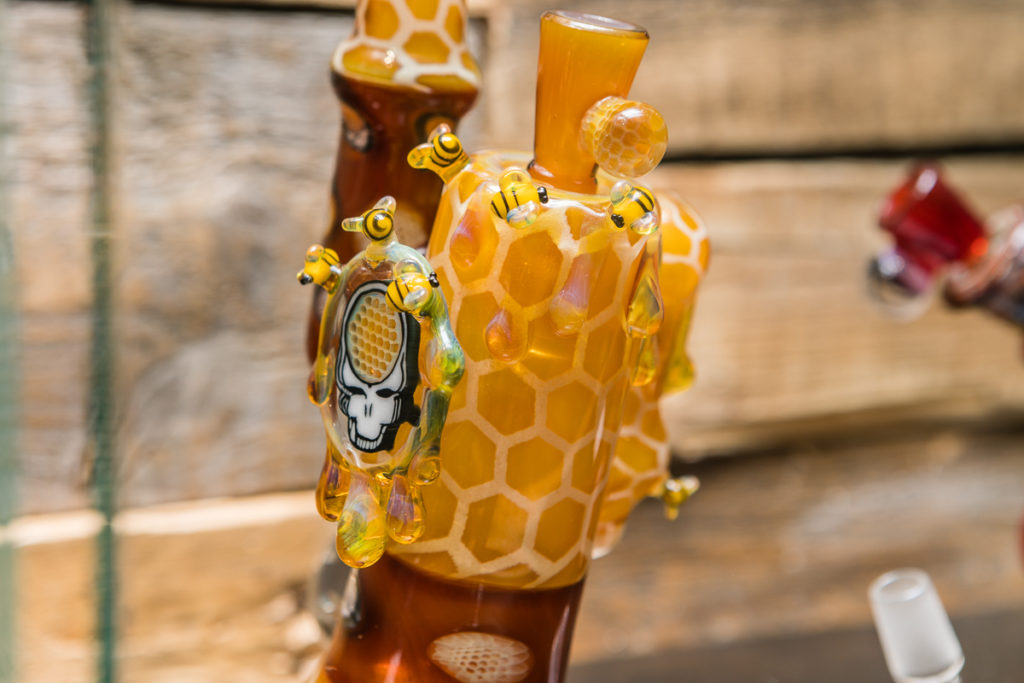
‘Steal Your Honey’ bubbler by Joe P & Jerry Kelly – ©Nick Cosentino
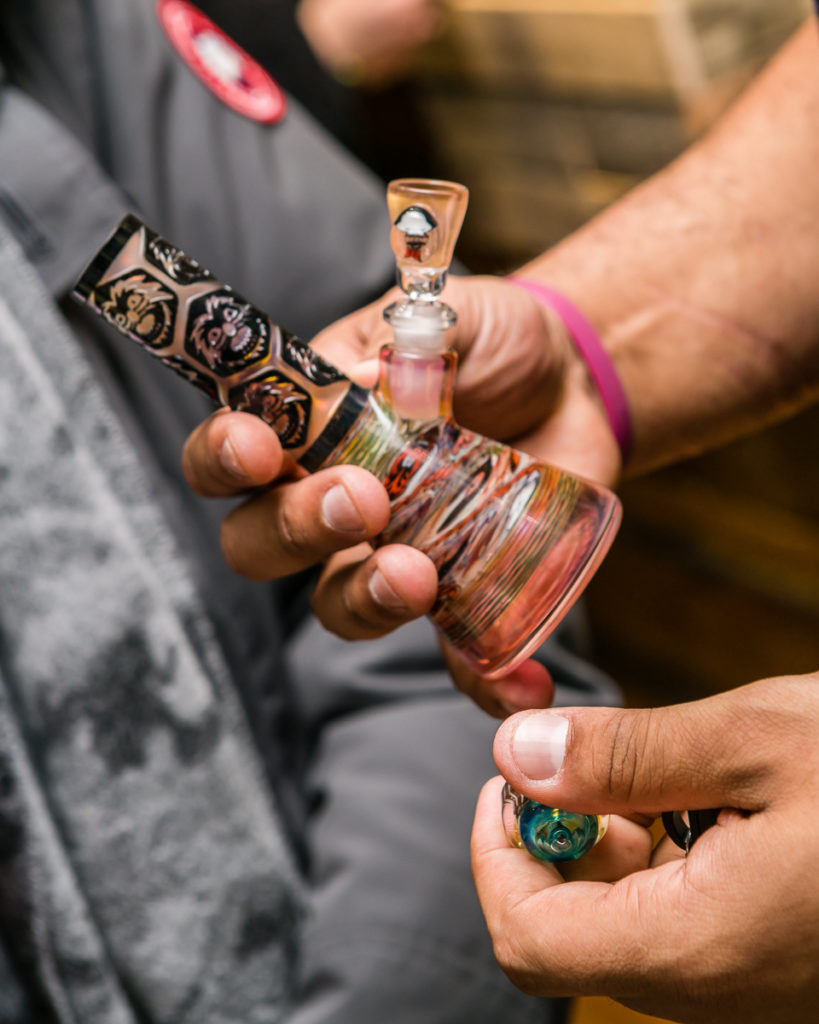
‘Electric Mayhem’ mini-tube and DreamLab x Jerry Kelly DreamTotem carb cap. – ©Nick Cosentino
Upcoming Releases – February 2017 [UPDATED]
February 4th, 2017 – ‘Totems & Tomahawks’ release online
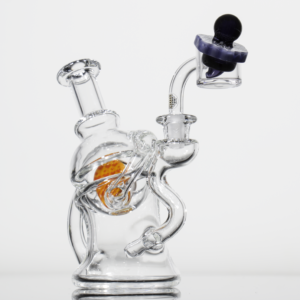
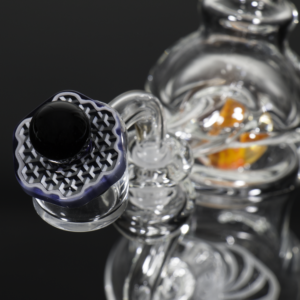
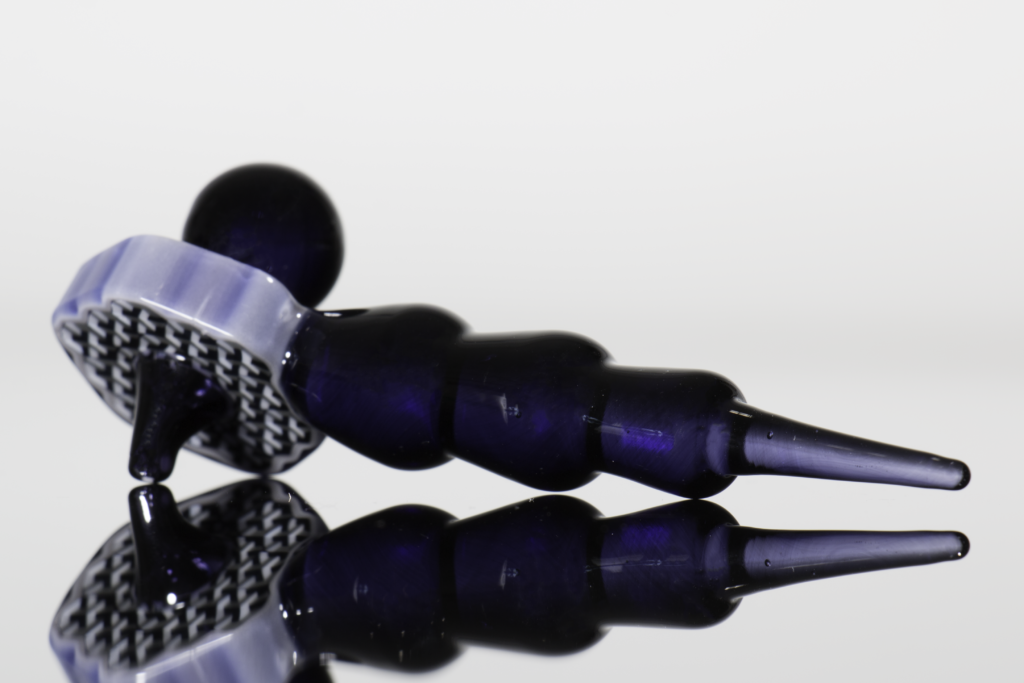
February 4th we’ll be release two new products through our official online shop. The classic DreamTotem is re-designed to offer more functionality. One side fits comfortably inside XL quartz, set it and forget it. The reverse side features a marble which can be used to cap regular size quartz without filling the bucket. The totem is again combined with our discontinued OG dabber to create our newest product the Tomahawk. After using the dabber side the user can quickly re-position the Tomahawk to use either the directional-flow nozzle, or marble for smaller quartz.
February 17th, 2017 – DL Quickstrike @ Rodeo Smoke Shop in Riverside, CA
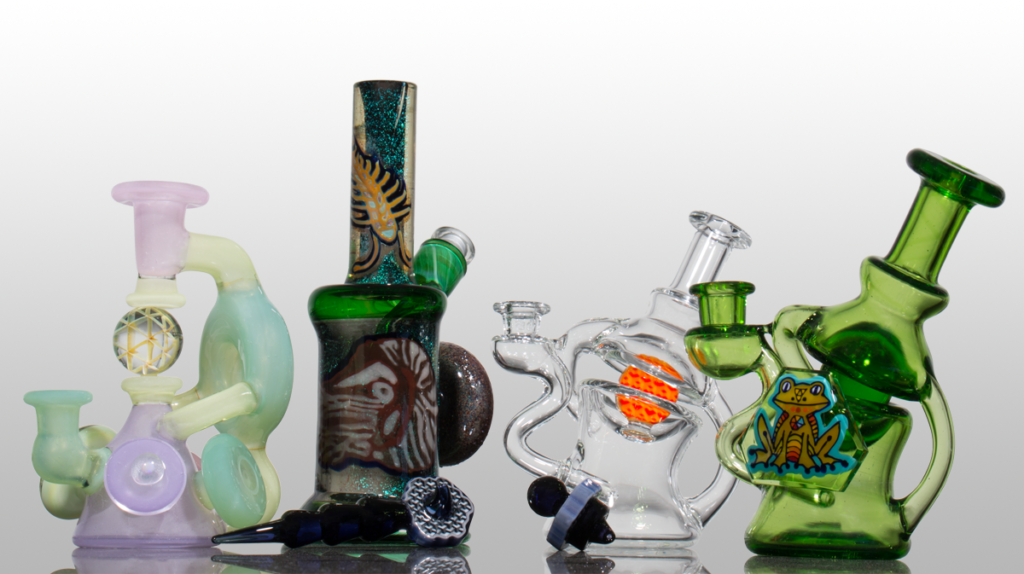
For our third Quickstrike release of the year we’re teaming up with one of So-Cal’s finest Rodeo Smokeshop in Riverside, CA. The drop features DreamLab solo work, a collaboration with Joe P, and solo work from DreamTeam member Mongrel. Contact Rodeo for more information.
February 25th, 2017 – DreamLab SYNDICATE @ Boro Brothers in Massapequa, NY
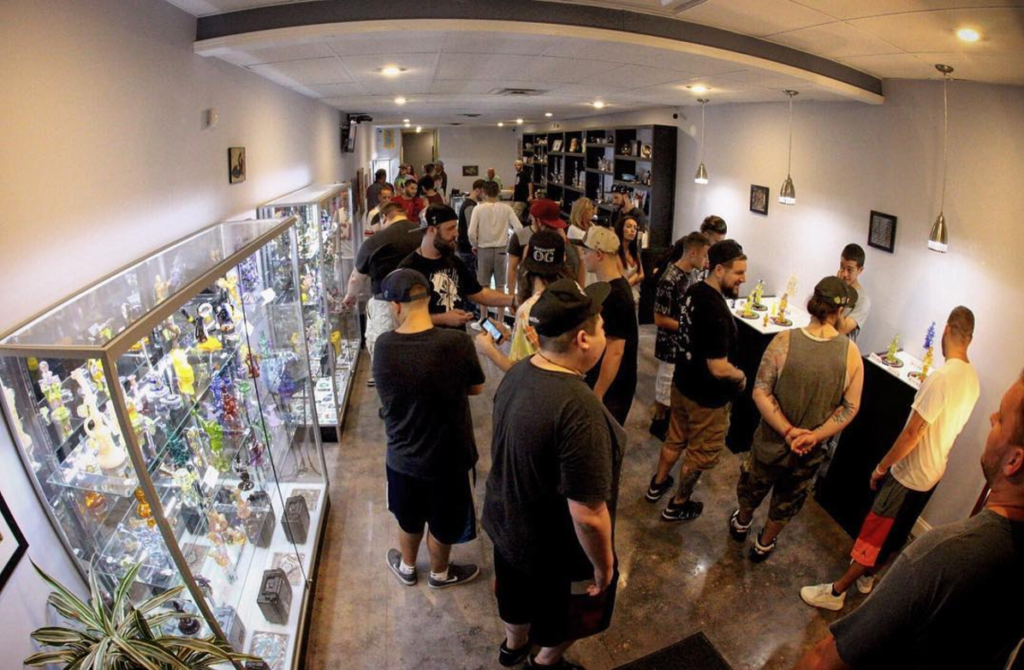
The first stop on the DreamLab Syndicate tour. We’re excited to be releasing our entire 2017 lineup featuring limited edition colorways and insignia designed in-part with Boro Brothers. Stay tuned to our instagram for updates.
February 25th, 2017 – ‘????’ release online

Too early to tell! stay tuned to our instagram and the blog for updates!
Upcoming Releases – January 2017
January 9th, 2017 – DreamTotem Drop (Online) – SOLD OUT
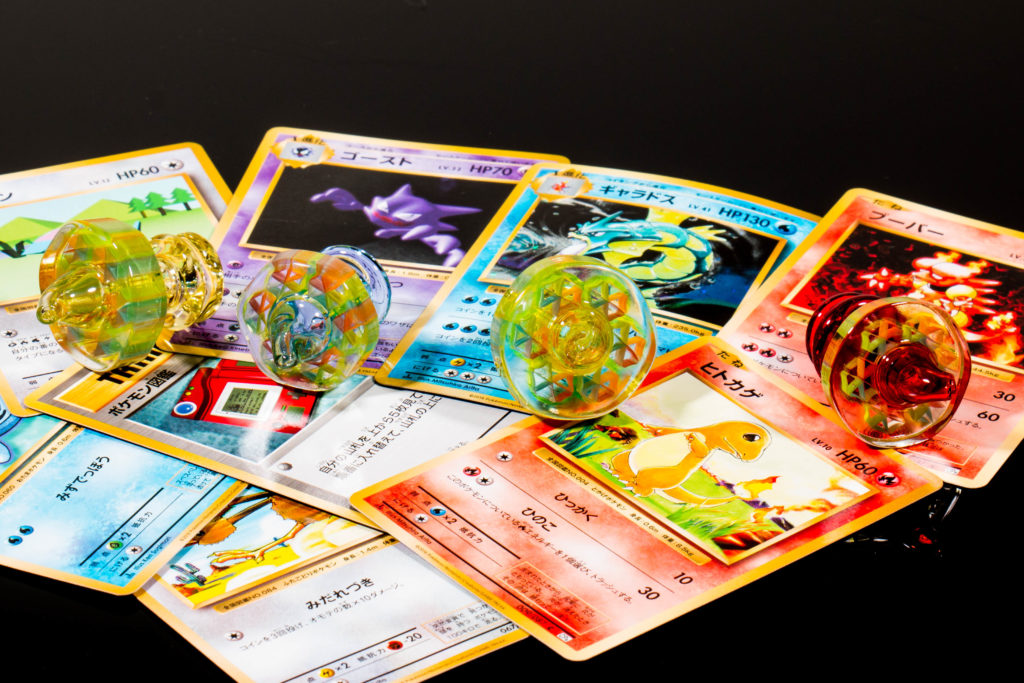
Released online 1/9/2017. (from left to right) Serum, Raindrop, LemonDrop-Tangie, and Pomegranate.
January 14th, 2017 – DL Quickstrike @ Holy Smokes in Miami, FL
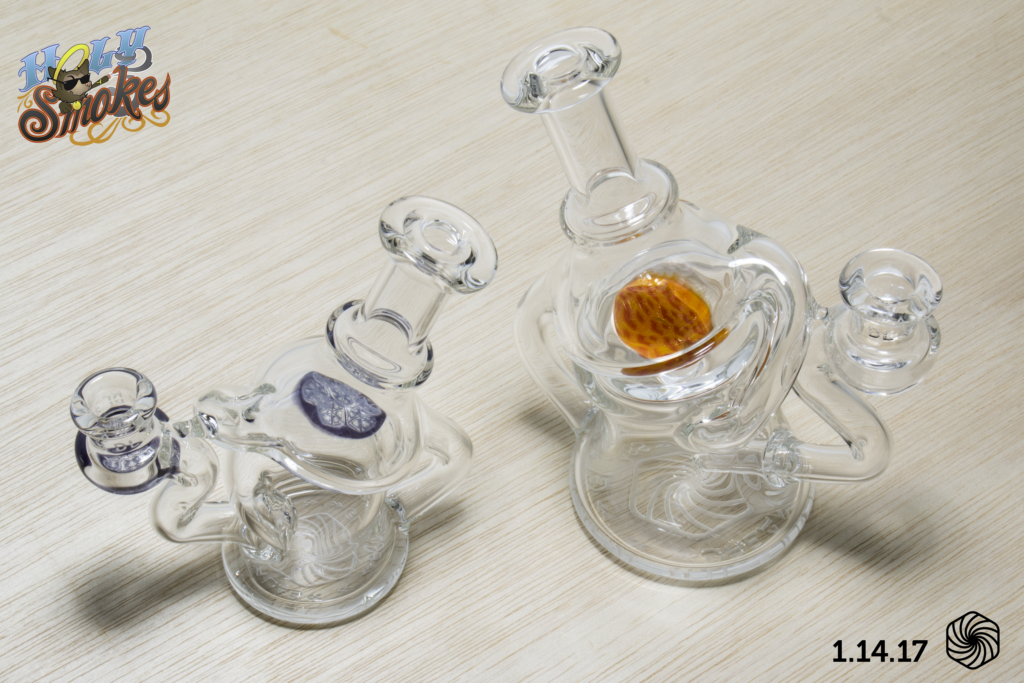
10mm Nano-Biosphere (CLR/2NDCRUSADE) & 14mm Hemisphere (CLR/TOOMUCHSAUCE) available 1/14/2017 at the Holy Smokes Bird Rd. location in Miami, FL.
January 21st, 2017 – Tumbler Drop (Online)
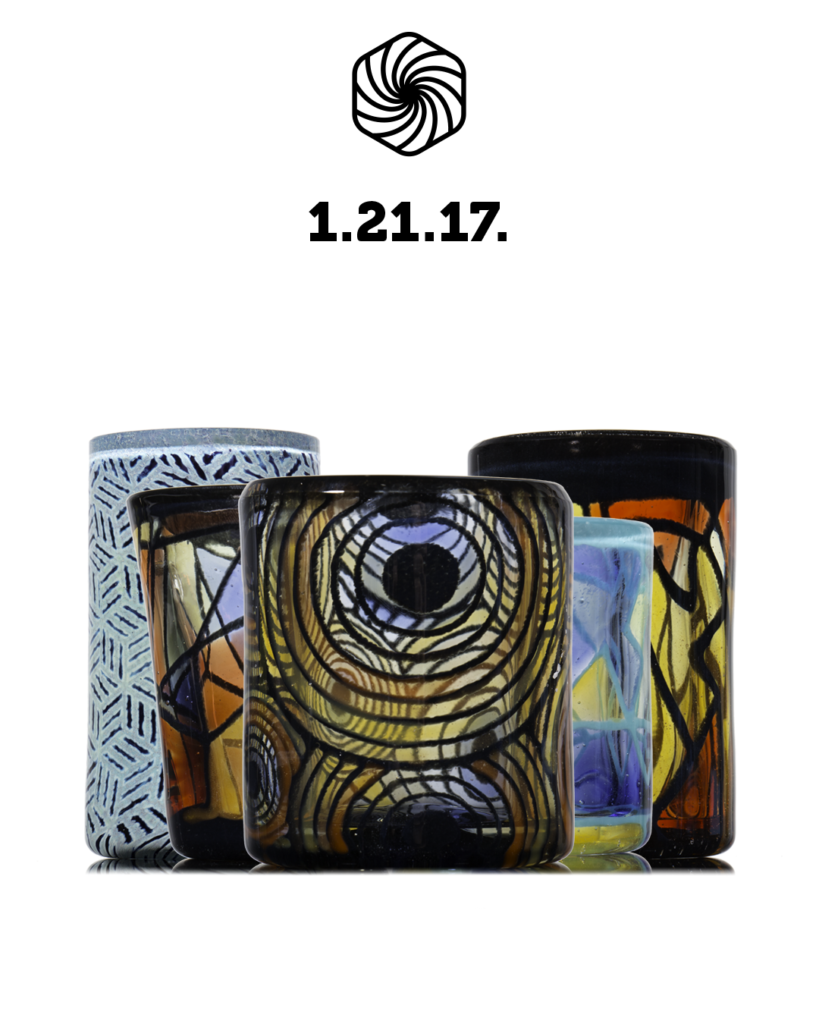
Releases online 1/21/2017. Accompanied by a limited-run DreamTotem release.
January 28th, 2017 (CNY Drop) @ Matchbox in Philadelphia, PA
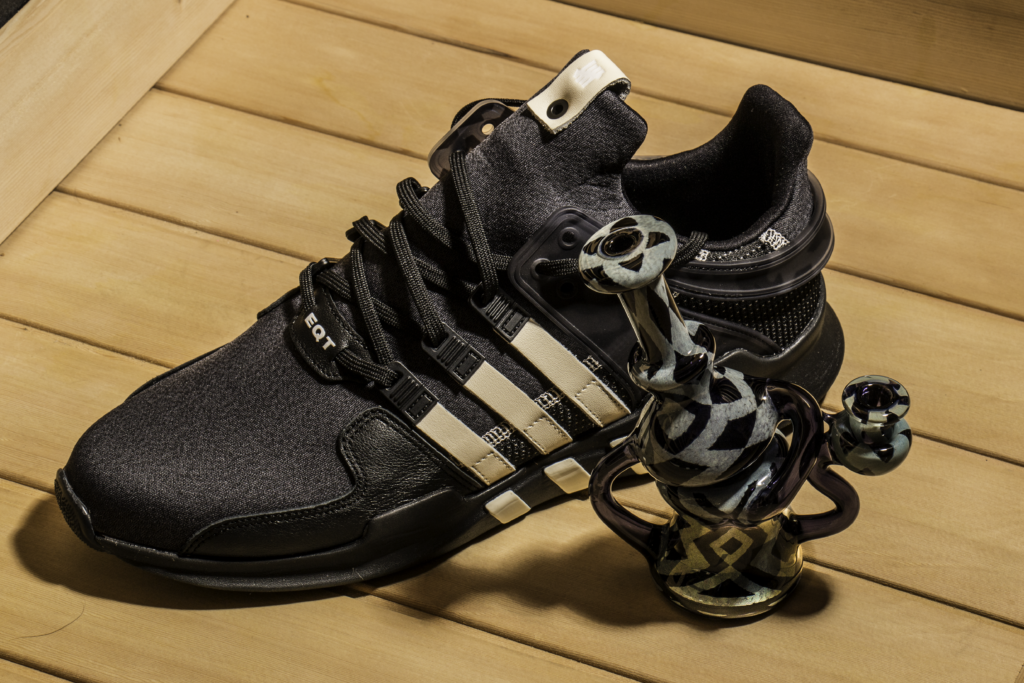
Exclusive Chinese New Year release. Available 1/28/2017 at Matchbox in Philadelphia, PA.
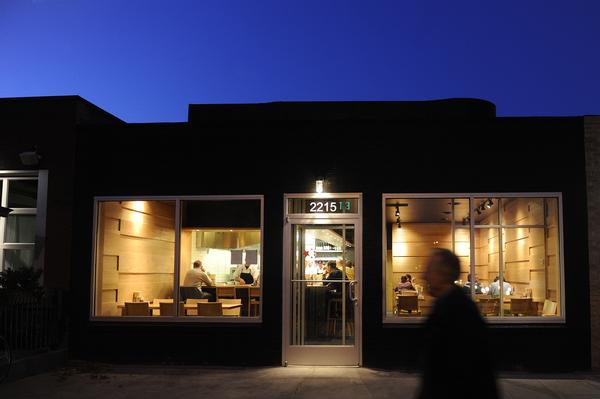
Uncle – Denver’s Ramen Masterminds
A big reason behind the success of Japanese ramen noodles has been the numerous regional varieties that have sprouted up in various parts of Japan. From the rich and creamy tonkotsu ramen created by street merchants in southwestern Japan to the ‘anything goes’ approach of Sapporo-style miso ramen in the north, each shop creates its own unique flavor signature. For many years these regional styles didn’t stray too far from their home-towns. Around the late 90s with the increased accessibility of the internet, knowledge of these regional ramen styles became more available to people. This sparked the first ‘ramen tourism’ in Japan. Fanatics of the dish would travel to very small towns just to have a particular bowl of ramen. This activity soon spread to other types of Japanese cuisine, and has in recent years, made the trip across the pacific to the United States. Shows like Anthony Bourdain: No Reservations and Diners, Drive-ins and Dives are just a few Emmy-winning shows that romanticize the concept of food tourism in the U.S.
While it’s possible to travel the country in search of say, a regionally unique Mexican food or BBQ, the chances of finding regionally-distinct Japanese ramen in the U.S. could prove to be a daunting challenge. This however is not at all a bad thing as the American palate is expanding beyond what has mostly been instant noodles in a styrofoam cup. Most shops these days will offer one or multiple varieties of popular Japanese ramen styles, such as tonkotsu, shoyu (soy sauce), or miso.
The ramen-obsessed chefs at Uncle in Denver, Colorado do things a bit differently.Using both locally-sourced and seasonal Japanese flavors, their ramen has a regionally-authentic taste. Having been the restaurant that has formally introduced the city to great noodles and broth, don’t be surprised to find yourself having to wait for a table. Luckily for this review, fellow DreamLab staff member Amy Sawchak and myself were given the chance to leave the office early to be the first in line to grab a table. Only open for dinner-service, Uncle does not offer call-in reservations so you will have to show up before you can ask for a table, and at certain times this can mean up to a 90 minute wait or more on some nights. However, in all seriousness I would wait much longer for a bowl of their delicious ramen as it is well worth the wait. (Pro tip: We recommend going on a weeknight as the weekends are extremely busy, even better if you can arrive just before they open the doors at 5pm.)
Uncle offers a lot more than just ramen, which is a unique twist I welcome from American ramen shops. In Japan ramen is an institution built around getting in, eating and getting on with your busy day. Whereas the American shops tend to blend a gastro-pub or ‘Izakaya’ element in to the experience.This means good alcoholic drinks, appetizers, and of course ramen. Their beer and wine list features both local and Japanese options along with seasonal cocktails, all of which rotate seasonally. This visit we decided to get the special appetizer for the season, an heirloom tomato poké featuring cucumber, fresno peppers, and locally-grown Colorado melon. The mild heat of the fresno pepper complimented the freshness of the melon and cucumber, making it a perfect early dinner treat after a day in the Colorado sun.
While it may seem like they are always finding ways to diversify the menu Uncle does offer a host of signature mainstays I always find myself ordering time and time again. One of the most difficult choices you may have to make during your dining experience is picking which type of steamed bun to order. Choose from an option of: fried green tomato, pork belly, shrimp or soft shell crab, with two buns per order I would recommend picking two of their four options and having some fun trying the different kinds (if you’re with a friend or two). My favorite is their soft shell crab steamed bun, which is garnished with masago mayonnaise, avocado, and pickle. The contrasting textures of the crispy yet succulent crab and the soft steamed bun create a feeling a sheer bliss. Masago mayo and avocado provide a creamy, yet zesty undertone, the crunchy pickle at the end invokes memories of eating a Chik-Fil-a sandwhich, which is never a bad memory.
I visit Uncle quite often, so usually I find myself ordering a bowl of ramen and calling it a night. But if you’re lucky enough to have the time to sit down and have some of their delicious appetizers like we did, it only gets better from there. Uncle has five varieties of ramen all crafted in-house, but in my opinion one of those five stands out among the rest. Made using what they call a ‘spicy sesame broth’ their spicy chicken ramen is one of my favorite ramens of all time.
I feel like this is a big statement for me as I have been lucky enough to try a lot of good ramen, including some of the most famous establishments around Japan. By using local ingredients and Japanese flavors, Uncle has successfully created one of America’s first regional styles of ramen ‘Colorado-men’ if you will. Spicy ramen like this is called ‘tan-tan-men’ in Japan and draws more influence from Chinese cooking than it does Japanese. This however is much different from the tan-tan-men I’ve tried in Tokyo, as it has a rich sesame flavor and is topped with rotisserie chicken rather than roast pork. The Spicy Chicken Ramen has become so popular that Uncle has begun to offer the same taste for vegetarians by using their veggie-miso broth and is topped with fried tofu rather than chicken. Some friends I’ve gone with have said the taste I love so much is that of ‘tahini’, a sesame paste essential to middle eastern cooking, but I’m not going to make any attempts at guessing, I’d rather keep slurping my bowl in bliss.
Uncle is open Monday thru Saturday from 5pm to 10pm and is located in Denver’s hip and happening Highland neighborhood just northwest of the city-center. For more information about the shop, or their menu items check out their Official Website.
Art Review: The Nature of Horses
Deborah Butterfield: The Nature of Horses, Denver Botanic Gardens
This summer, DreamLab Glass crew members Amy Sawchak and Glass Otaku paid a visit to Denver’s Botanic Gardens to check out this year’s outdoor exhibition by renowned artist Deborah Butterfield.
Anyone who’s ever flown into Denver has certainly seen Blucifer, the demon horse of the DIA. This petrifying sculpture instills fear on all who lay eyes on him. So often, the subject of the horse is depicted as a violent animal used for battle. Deborah Butterfield’s artwork at the Denver Botanic Gardens embodies the complete opposite of this depiction. The collection is composed of 15 of Butterfield’s astoundingly beautiful equine sculptures placed thoughtfully throughout the gardens. The overall tone of these equine sculptures is restful, they are not active, but passive which resonates well with the curated plant life.
Deborah Butterfield is often considered a sweetheart of American sculpture and her interpretation of life-size horses has been the subject of her sculpture for more than 30 years. She began creating this work with ceramic, moving into found objects and industrial material, and ultimately into the bronze cast branches that make up the majority of her work at the Denver Botanic Garden.
This exhibit contrasts the busy and color laden exhibit from Dale Chihuly last year with a much quieter and reserved display of work. You are able to soak in the gardens and subtly approach these giant beauties in your own time. The transition between the landscape and the sculptures feels as if you are approaching them out in nature, as if they have been there all along. The simplicity of the work allows the viewer to absorb what feels like personalities or emotions radiating from the horses.
As we wandered through the gardens, it was also hard to ignore people’s reactions to the work. We heard quiet gasps as people discovered the sculpture and noticed them as they took a thoughtful amount of time to soak in the work. I observed an elderly couple seated, holding hands and smiling, across the pond from one of the larger works, a mother and her young children gathered around a piece in deep conversation about the material, and a couple walked briskly to discover where the next sculpture was nestled. This exhibit is undoubtedly loved by the public not only because of its beauty but also because it inspires people to become careful observers which instills a meaningful discussion about the work.
We sat down with the garden’s communications manager, Erin Bird, to discuss the summer exhibitions. She explained that the artists are selected based on the theme chosen by the curatorial staff. This year’s theme was the Great Plains and similar steppe ecosystems and they could not think of a more complementary artist than Butterfield to synchronize their vision. The Botanic Gardens came to exhibit this body of work by conversing with the artist to make her largest solo outdoor show a reality. The collection is on loan from the artist, museum collections, private collectors, and universities from around the country. Bird also explained that the exhibit has been very popular with the public and is frequently described as elegant and graceful. A resounding reaction is the shock that viewers experience when closely observing the material, only to find out that the sculptures are made of bronze, and not of the driftwood that most assume they are. It is also assumed that the work arrives in pieces and is constructed on site, but in fact each of these sculptures which weigh thousands of pounds, is actually crane-lifted into the site.
The eloquent harmony created between her work and the landscape of the gardens is an essential experience if you are in the Denver area. But be careful; because of the popularity of this exhibit, the gardens are mobbed during the weekend. If your schedule allows, we recommend going on a weekday morning, even if that means calling in sick to do so.
This exhibit closes on October 18th but the Botanic Gardens are open all year round. For more information please visit http://www.botanicgardens.org/.
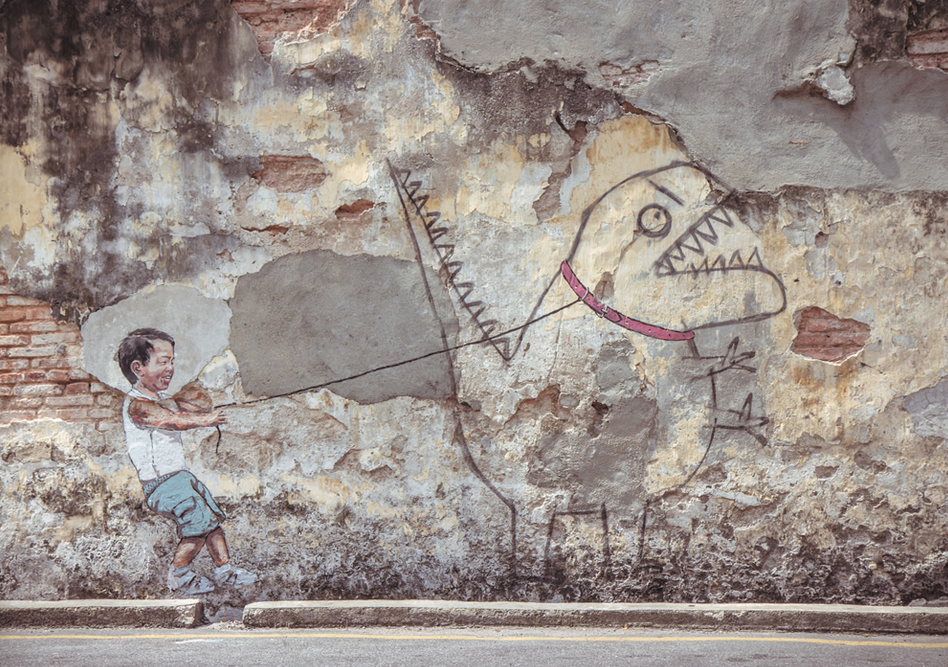
Penang, Malaysia: Street Art Unites Past and Future
Following our short visit to Tokyo for the All Japan Show, Joe and I continued our journey in the Orient by way of Penang, Malaysia, an island off the country’s northwest coast near the Straight of Malacca. The reason for this several day stop in Penang was personal, it is the home town of my girlfriend, Janice, whose parents I was meeting for the first time. Joe reluctantly agreed to join me on this adventure because I promised that we could also spend some time scuba diving, a blog post highlighting our scuba adventures will appear on this site soon.
Penang, is a hot, bustling island most of the year. Since the 18th century, it has had a rich history as a British colonial port, and trading has brought much diversity to the area, with roughly half the population being descendants of Chinese immigrants and the other half split between Malay people and Indians. The gap between rich and poor is also quite apparent. As we walked from our hotel along the shore to get breakfast, Janice pointed out to Joe and I that the apartments and luxury condos inside the brand new high rise buildings that towered above us were several million dollars a piece to buy. Several dark-skinned laborers, most of whom are recent immigrants from India and Bangladesh sat in the shadows of these buildings smoking cigarettes, waiting, I imagine to get picked up for a manual labor job. As we spent most of the day inside an air conditioned mall that sported luxury brands from the US and Europe, we could see that many people who worked at these malls could not afford any of the products on the shelves. It was plain to see that there is a large gap between the rich and poor in Penang.

Joe P scans the view from Kek Lok Si Temple in Penang
As the post WWII economy of Penang grew rapidly, so too did the cost of housing. High rise apartment buildings and luxury developments forced many of the city’s low-income population who lived in the historic parts of town to move to cheaper areas of the island. In response to this devastating trend, in 2008, UNESCO declared George Town, the historic center of Penang, to be a World Heritage Site for having “a unique architectural and cultural townscape without parallel anywhere in East and Southeast Asia.” The goal was to conserve the historic identity of the island which is exhibited in the ordinary life and culture of the working class people who were being forced out by the new money from the banking and tech industries.
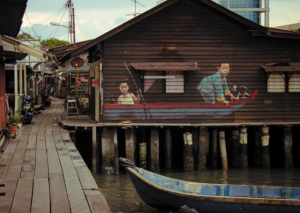 As part of the George Town Festival in 2012, a young Lithuanian street artist, Ernest Zacharevic, was commissioned by the city to paint six murals on historical buildings in an effort to highlight local life there. What made these murals particularly interesting to me was the inclusion of mixed media elements into the mural. For instance, the most famous of the 2012 murals is of a young girl and boy riding a bicycle. While the subjects of the mural are painted, the bicycle is real and fixed to the wall permanently.
As part of the George Town Festival in 2012, a young Lithuanian street artist, Ernest Zacharevic, was commissioned by the city to paint six murals on historical buildings in an effort to highlight local life there. What made these murals particularly interesting to me was the inclusion of mixed media elements into the mural. For instance, the most famous of the 2012 murals is of a young girl and boy riding a bicycle. While the subjects of the mural are painted, the bicycle is real and fixed to the wall permanently.
One might think that if a town wanted to celebrate its history, they would commission jaw-dropping work that would most certainly become a landmark. While they aren’t tremendously impressive paintings in terms of their size or complexity, they are stunning because they glorify working class life in Penang. Another question that comes to mind is why the city would hire an outsider to paint the walls of an historic city and not a local. But, Zacharevic’s take on local culture is certainly relevant because over the last three years it has come to be adopted by both locals and tourists as work iconic of Penang. As Joe, Janice and I observed the bicycle mural in the setting sun, a line of people formed to take their picture with the mural; Zacharevic’s work certainly has certainly succeeded in becoming a town landmark.
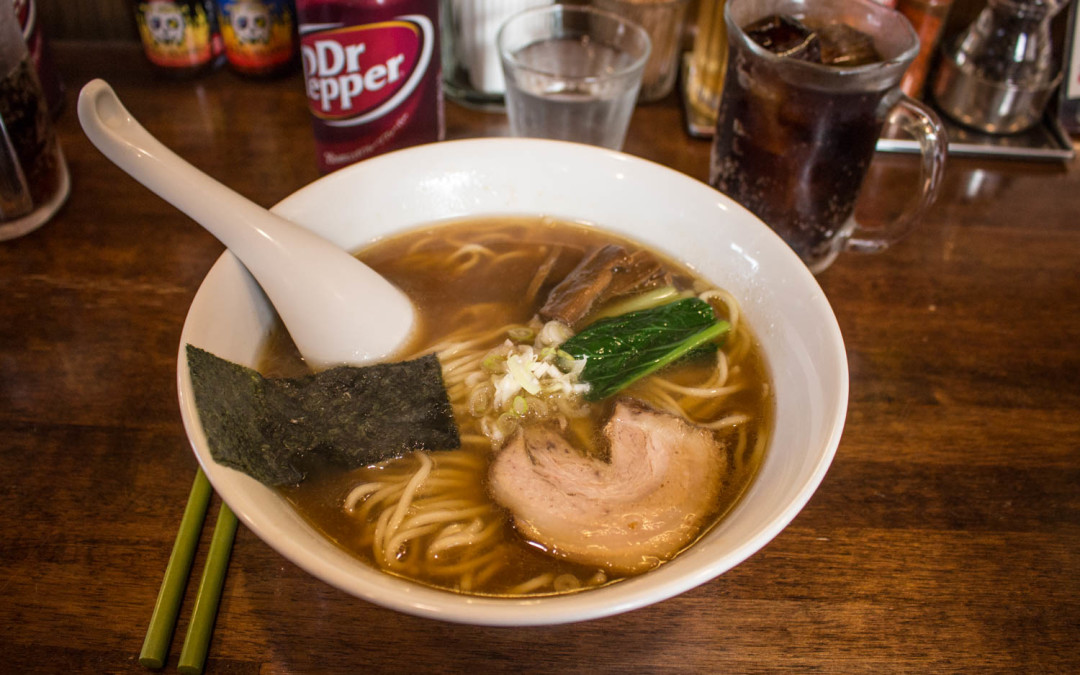
ラハメン ヤマン – ‘Yahman Ramen’ – Nerima, Tokyo – Japan
As you will quickly learn in this blog series, each town in Japan I visit is famous for its own unique flavor. This regional variety is the kindling which drives the spirit of the modern day Ramen enthusiast. Japanese-style ramen as we know it today has been around for about 100 years, with the first recorded establishment having opened in Yokohama (a town near Tokyo) in 191o. This shop became famous for serving Chinese-style noodles in a distinctive Japanese style broth based on soy sauce or ‘shoyu’ in Japanese. This gave birth to Shoyu Ramen, hands down the most popular ramen style in Japan and around the world today. Ever wondered what flavor ‘Orginal’ top ramen was? well it’s Shoyu. With its rich yet light taste which the Japanese ‘Asari’ shoyu ramen is without a doubt a quintessential representation of Japanese culinary philosophy.
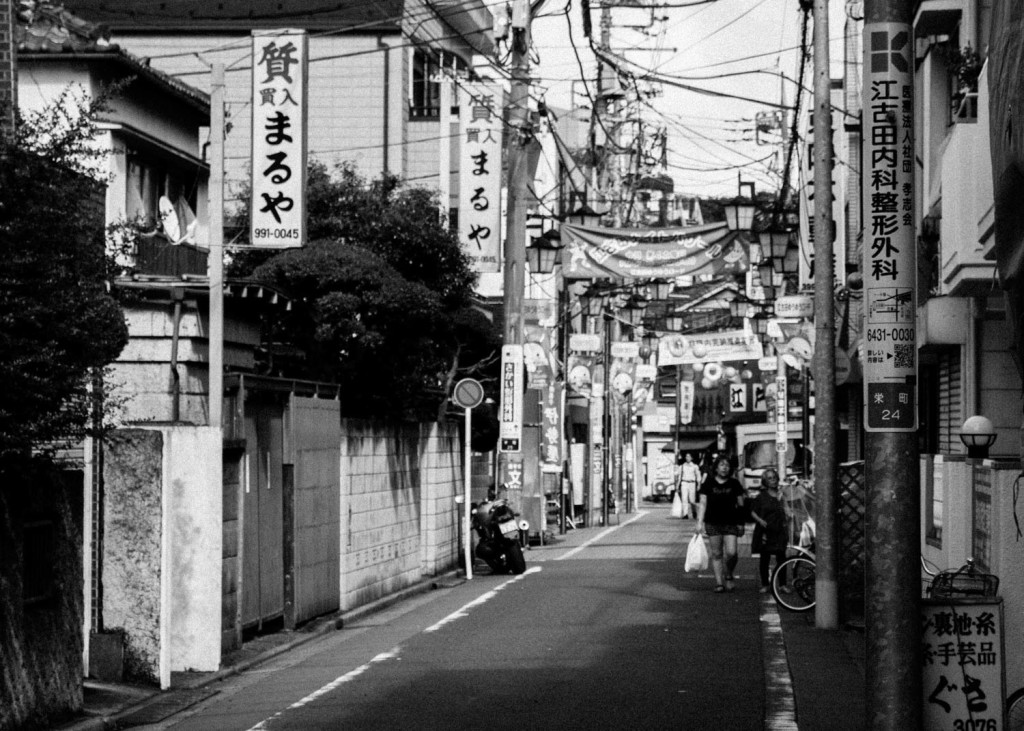
On our trip for the All Japan Show this summer, the DreamLab Glass crew and myself made it a point to sample the best shoyu ramen the sprawling metropolis had to offer. I had read about this particular shop in a book which showcased Tokyo’s best ramen shops, and felt it was necessary to check it out for our readers. Our glassblowing friend and Tokyo-local, Keisuke Yoshida, picked us up from the Le Deco gallery where the All Japan Show was currently being held for its several day run. After about a 30min drive from the center of town, we found ourselves in the Nerima ward. Keisuke was able to use his GPS to find us a parking spot just down the street. If you are in Japan and plan on taking the train, which works best for most visitors, just hop on the Fukutoshin line at Shibuya Station and take it to Shin-Sakuradai Station.
After such a long drive out into the city we were ready for what can only be described as an ‘irie’ bowl of Shoyu ramen. With dub beats flowing out the speakers, images of reggae’s patron saint Bob Marley hanging on the wall, and the head chef sporting dreadlocks, this is definitely a shop with ‘positive vibrations.’ The interior is awesome. But be sure to look out for all the secret menu items hidden in obscure locations.
If you don’t speak or read Japanese I would most definitely recommend bringing a friend who does to make the whole experience a little easier. The whole menu is in Japanese, but in most shops you can ask them which is the most popular style and they will point you in the right direction. Let me take something back I said previously, there is one item written in english on the menu, Dr.Pepper. I felt like this was a sign, like this soda would be the perfect compliment to my meal. Upon ordering it the shops server pulled a frosty mug from the freezer and loaded it with ice. The chilled mug made a big impression on me, I felt like it somehow enhanced the flavor of the soda and gave the appearance a sophisticated look which is often lost on soft drinks.
Our guide Keisuke ordered the tsukemen ramen, which was honestly the best decision given the time of year. Instead of a hot broth it is chilled and reduced into a slightly more concentrated version of the soup. With tsukemen you dip the noodles in the broth rather than immersing them in soup like traditional ramen. I would recommend ordering tuskemen in the summertime or if you are looking for a very ‘local’ ramen experience. According to the time of year certain shops will offer either a hot or cold tsukemen option.
I was able to get my booked signed by the head chef which was an amazing experience for me. Be sure to join me again on my ramen adventures, who knows where I will be slurpling next!
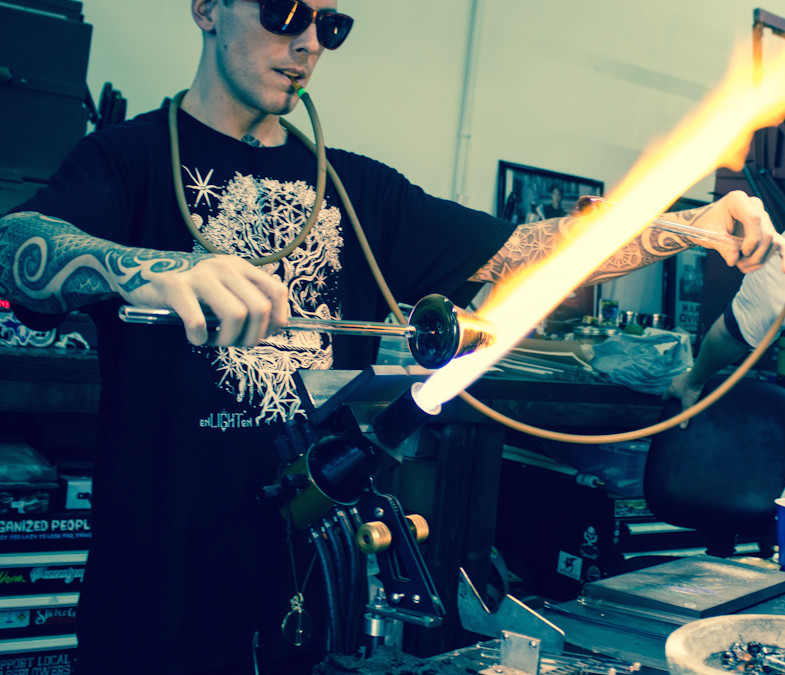
An Interview with Nathan ‘N8’ Miers
Recently we sat down with DreamLab’s co-founder Nathan ‘N8’ Miers to learn more about his history as a glass artist. During this interview we get in-depth information on Nathan’s early years, his beginnings on the torch, as well as the foundation of Everdream Studio and DreamLab Glass.
DL – When did you first become interested in art?
N8 – Growing up, I had a million-and-one hobbies and interests. I remember wanting to be an inventor one day, then an engineer the next. During that time, I found art and drawing and it just stuck, I’ve been doing it ever since.
DL – When did you first start making glass art?
N8 – In college, I met a glassblower named Chico and he was kind enough to let me watch him work on the weekends. Then I started doing some of his basic tasks for him like welding handles together. Pretty much the rest is history…
DL – What made you interested in making glass pipes?
N8 – I always knew I’d end up in some sort of artsy career, but I thought in my early years it would be graphic design or illustration. I worked in a print shop and did a lot of freelance design in college, which challenged me while educating me on the basics of design, but the 9-to-5 lifestyle was too structured for my free-spirited ways. During those years I was introduced to collectible glass, pipes and otherwise, and thought to myself, “Hey, I bet I could do this!”
DL – What artists inspire you?
N8 – These days I look at a lot of tattoos and street art in my spare time. I appreciate the effect street art has on public space, and both of those mediums share a common bold aesthetic that I really enjoy. I also respect the fact that those two mediums, as well as glass pipes, initiate a fresh dialogue on socially taboo topics. Two glass artists that inspired me in the beginning of my career were Clinton Roman and furnace-worker Dante Marioni. Clinton was a local artist from WA who’s work inspired me because I could actually hold it and look at the details. I discovered Maroni’s work later on through the web, and it challenged me to refine my aesthetics and be mindful of my color use.
DL – Where do you draw inspiration from in your life to make your work?
N8 – Everything; life is art. So glass, or whatever medium I’m working with is an extension of that. Even something as mundane as organizing the shelves in my kitchen can become an art project to me. With that said, it’s often some little design from cheesy restaurant wallpaper or the flashy color-scheme of some useless and unrelated piece of plastic junk that makes it’s way into my work.
DL – How would you describe you body of work?
N8 – I’ve been having a lot of fun working within the space-theme for the last few years and have created a very large body of work with the Intergalactic theme that I’m very proud of. As of late, I have been really captivated with making murrine, which has given me a chance to work once again with a vibrant color palette and the symmetry/organization aspect that drew me into glass, as can be seen in my recent Kaleidoscope Murrine Projects.
DL – What music do you listen to and how does it inspire your work?
N8 – When I’m at work I like good steady beats, usually long electronic mixes that keep me moving and shaking.
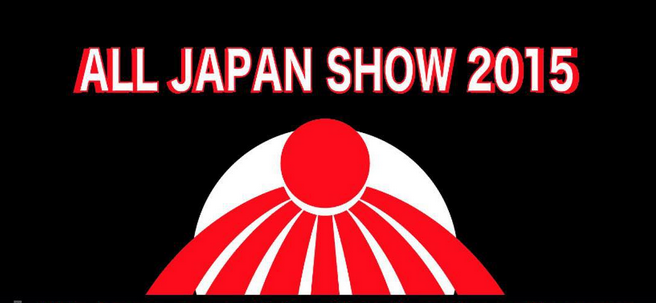
All Japan Show 2015
Immediately following Wookshow 3: Weekend at Graffy’s at Everdream Studio, members of the DreamLab Glass crew, Joe Peters, Glass Otaku, and myself, Dave Peters, flew to Tokyo to attend the 2015 All Japan Show. 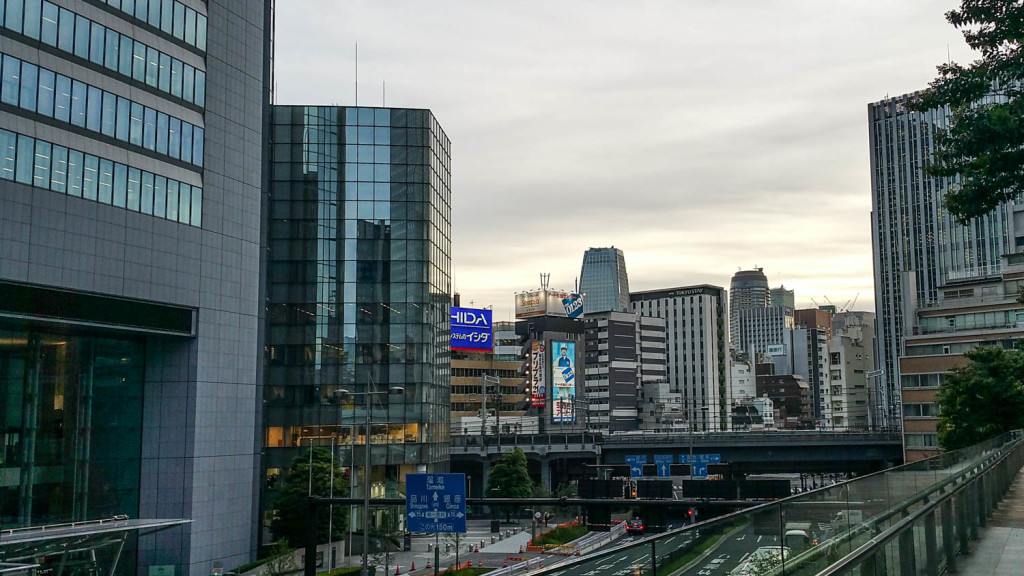
After an exceptionally long flight, we finally made it to the Park Hotel near Shimbashi Station in downtown Tokyo. The Park Hotel is decorated with modern artwork by contemporary Japanese artists. The hotel lobby is designed as a museum with large sculpture pieces, tapestries, and murals curated throughout the lobby and reception area.
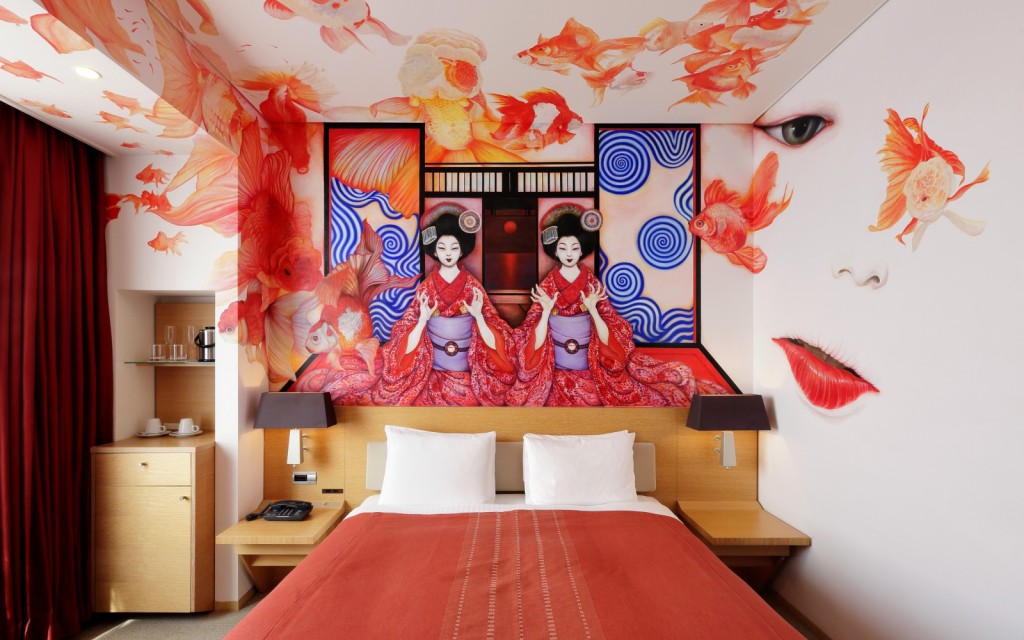
Another feature the hotel offers is Artists Rooms that are each individually designed by local artists. Joe had the privilege of staying in the room created by Aki Narita entitled, Geisha Goldfish. This room had goldfish painted all over the walls and ceiling that gave the illusion that the guest is floating inside an aquarium. There is also a bewitching geisha mural painted in the room. The room that Glass Otaku and I stayed in had a wonderful view facing southwest. In the early mornings we could see the gentle outline of Mount Fuji rising behind the concrete metropolis.
Once we had settled in, we prepared to go out to dinner with the All Japan Show crew, which includes some of the best borosilicate glass makers in the world. Generally speaking, the Japanese are known for their technical control in glassmaking and detail-oriented patterning. The patriarch of the group is Yoshinori Kondo on the account that his English is the most proficient. Other members include Junichi Kojima aka Rose Roads, Daisuke Saito aka DISK , Takao Mayaki, AKIO, T.K. Happa, Aquarius, and the elusive SLOP. It was a great opportunity to break the ice with both the artists and the show-goers, as we drank highballs and grilled tasty meats and veggies on the barbecue. The restaurant was a cook-it-yourself style Korean establishment, although it wasn’t traditional Japanese food, it was both fun and delicious.
The day of the show, our jet lag had the three of us tossing and turning around 5 AM, so we decided to head over to the Le Deco Gallery space, and to our surprise, we were the first three people in line. Moments later, Jon Green arrived and before too long, there was a twenty person queue of mostly North Americans waiting on the street outside the gallery space.
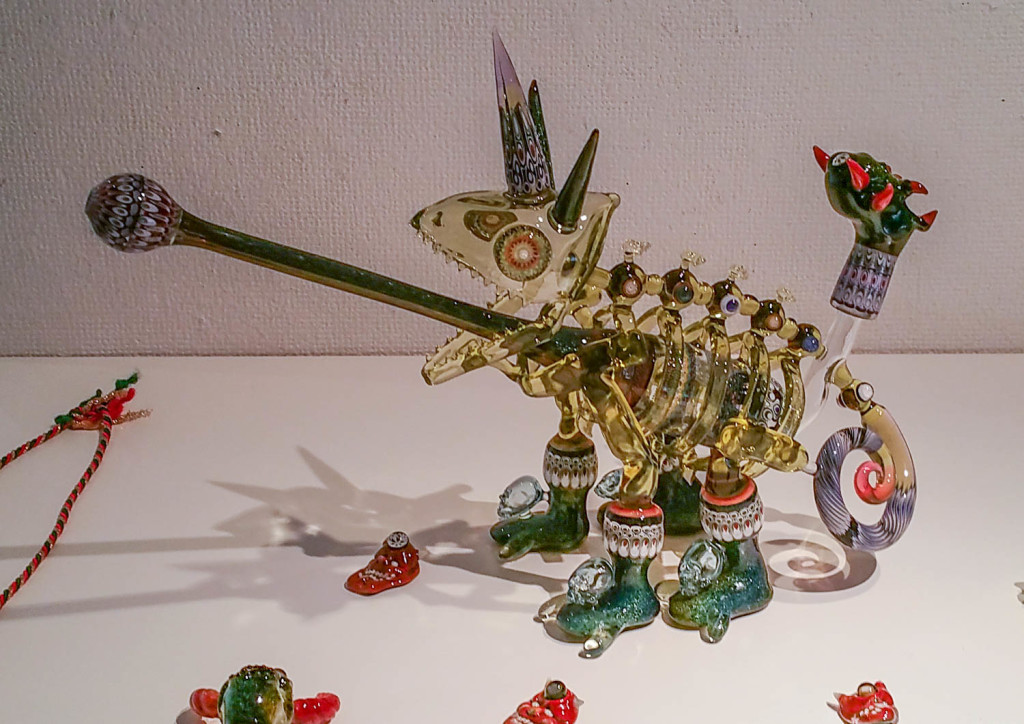
‘Onigari’ which translates to ‘Demon Hunter’ in Japanese. A collaboration by Yoshi Kondo, Rose Roads, Daisuke Saito, Takao Miyake, T.K. Happa, Aquarius, and AKIO.
We were so pleased that some of our old and new friends were able to make it to the show. One of the best glass blowers out there today Sleek was able to do some collaborations with Yoshi following the show. Some teasers of their pieces have been published on Sleek’s IG and look stunning. Sleek’s fellow shop-mate Nick Bailey was able to take some time to work with T.K. Happa after the show as well. We were also excited to see Adam Kandel, Brian Bowden, and the Hive Ceramics crew also came to the All Japan Show to support the efforts of Team Japan.
Sales at the show were determined by each buyer’s position in the line. As Joe, Otaku, and myself were the first three in line, we were able to have dibs on any three pieces in the show we’d like. After our initial selection of one piece each, the queue would continue on until the last person in line (#24, I recall) had chosen the piece they would like, and then it would reset back to the top. This sales strategy is the most fair style I have seen yet, because it allows just about everyone who is interested in purchasing to have a chance to get their desired piece.
All in all, it was a fantastic day. Joe managed to scoop the 5D C.U.P. by SLOP and a Rose Roads pendy with two smoking tipis for his persy collection. Mike and I grabbed a DISK yellow colorcomb mosaic mini tube. We also purchased the Kondo X Rose Roads “Kusanagi” pendant as well as an Akio X Kinda pendant for resale on the DreamLab Glass Vault, a fine art collection for resale through the DreamLab Glass online store.
We were so pleased by the turnout for the show and would like to deeply thank the Team Japan crew for putting on the All Japan Show this past August. We were so thankful that everyone who travelled to and from the show did so safely, and we look forward to a time when we can host the Team Japan crew back at our DreamLab Glass Studio in Evergreen, Colorado. Until that time there is still work from the show available on this website, and welcome anyone serious about purchasing to contact us through the site with inquiries.
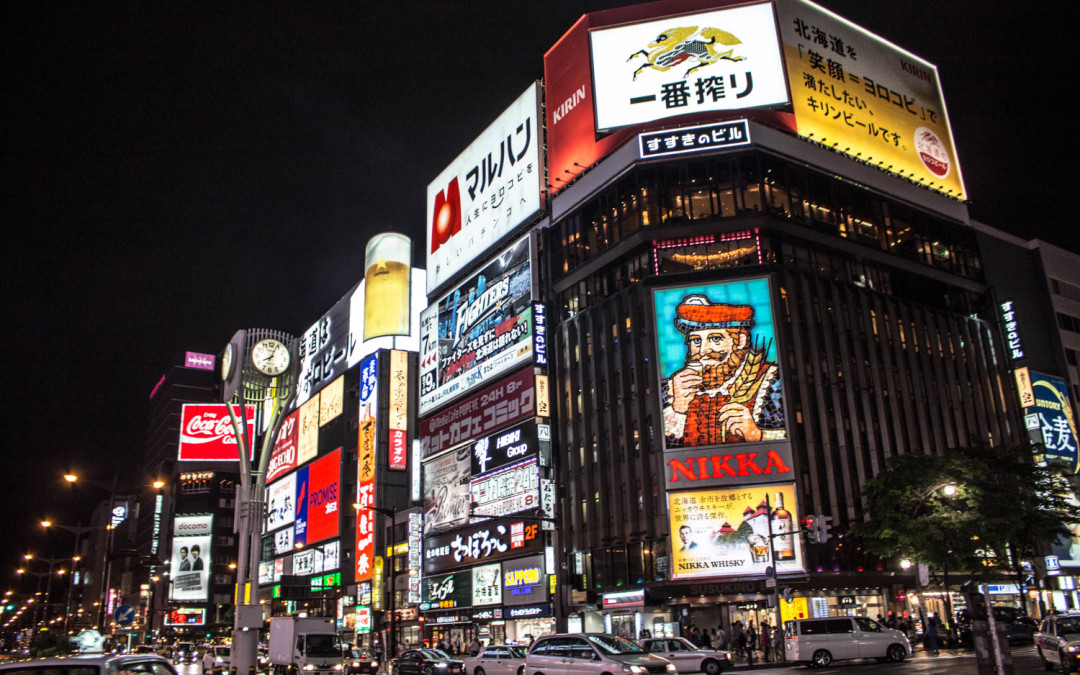
味の華龍 – ‘Aji no Karyu’ – Susukino, Sapporo – Japan
After the long process of finding my AirBnb condo, it was finally my first night to venture out into the city and find the best Japanese ramen noodles that Sapporo has to offer. The city is famous for miso-flavored ramen, which is made by taking delicious chicken and pork based broth and stir-frying it along with miso paste, bean sprouts, and cabbage. Since it’s creation here in Sapporo in the 1980s, this style has swept Japan as one of the most popular.
Weirdly enough, Sapporo’s most bustling part of town ‘Susukino’ is also it’s red light district. That being said, there is a lot more around the area than just hostess bars and strip clubs. In Susukino you’ll find many restaurants, stores, bars, as well as plenty of sightseeing and people watching. Taking hints from my idol Anthony Bourdain, I set out to this part of town in search of what the locals refer to as ‘Sapporo Ramen Yokocho’. In Japanese, this means ‘Sapporo Ramen Alley’, which is exactly what it sounds like: about ten or so ramen shops crammed into a single alley only wide enough to fit one person comfortably. As I approached the alley, the brightly lit signs and decorative flags signaled that I was in the right place. With a delighted curiosity, I took in the aromas from each shop. Some smelled unique, while others smelled like the traditional Japanese cuisine that I have become familiar with over the last few years. It wasn’t until I walked past the last spot along the alley that I detected the particularly delicious aroma of Aji no Karyu.
As I ducked my head under the ‘noren’ fabric I immediately noticed the entire room is filled with signatures. Immediately, the English font popped out at me ‘Magnificent! many, many thanks.’ signed by none other than ‘Anthony Bourdain and the No Reservations Crew’. At the moment, I knew I had made it somehow as a self-proclaimed foodie. It does seem a little kitsch to be excited to have eaten at the same place as a famous guy on TV, but he’s on TV because he likes good food and he chose this place… So it must be good right?!
After securing myself a seat at the bar, I immediately ordered the basic miso-ramen and a Sapporo Classic (Sapporo’s region-exclusive brand of Sapporo). During this time, the couple next to me get their bowls of noodles, and that moment I immediately regretted my decision to play it on the safe side…
I feel like every ramen pilgrimage has at-least one of these, what I jokingly call ‘the soup that got away‘. This miso ramen not only features a delicious piece of chashu roast pork and vegetables but also crab legs and clams, two hokkaido delicacies. I was certainly jealous of the gentleman who ordered it, but the ramen I got sure did not disappoint either.
Miso ramen has a rich and salty taste, yet it is also subtly sweet, which is what I think adds to it’s overall ‘rich’ complex. The chicken and pork broths combined with the miso paste are full of depth yet not too salty, letting the miso paste carry that load of the work. The crinkly Chinese-style noodles sop up the broth well in what can only be described as a symphony of flavor. The toppings: chashu roast pork, nori (seaweed), negi leek, onions, cabbage, bean sprouts and bamboo shoots all mixed very well with the broth.
Next time you find yourself in Sapporo, I would definitelymake the time to take a trip to Susukino Alley for one night on the town. I swear you will wish you had a few more! Also, if you find yourself lucky enough to try Aji no Karyu and see an open table, heed my advice and take it. I read in fellow ramen-lover Brian MacDuckston’s blog that he was snubbed a dinner there as they shut down for a private party, and while I was there, partway through my meal the shop owners decided to shut down the shop for what they called a ‘Private Party’ but essentially a Chinese tour guide had persuaded them to shut the store down so that everyone in his tour group could all eat at the tiny restaurant. Even in Japan, it feels like the Chinese are taking over the world.

